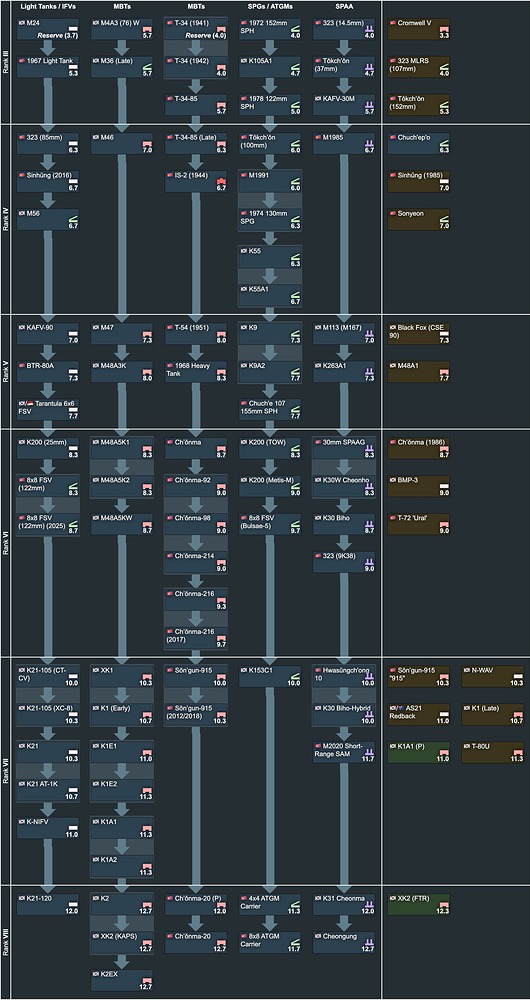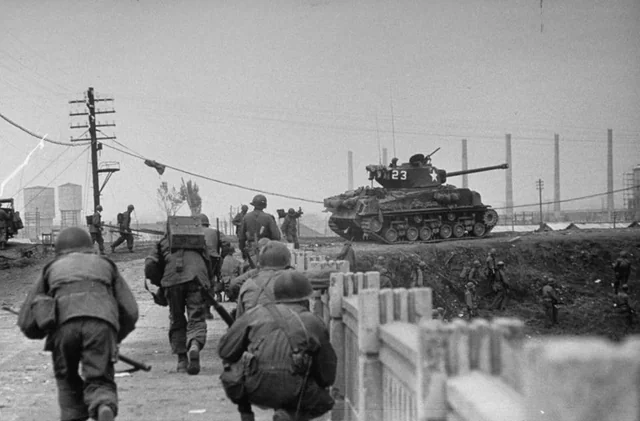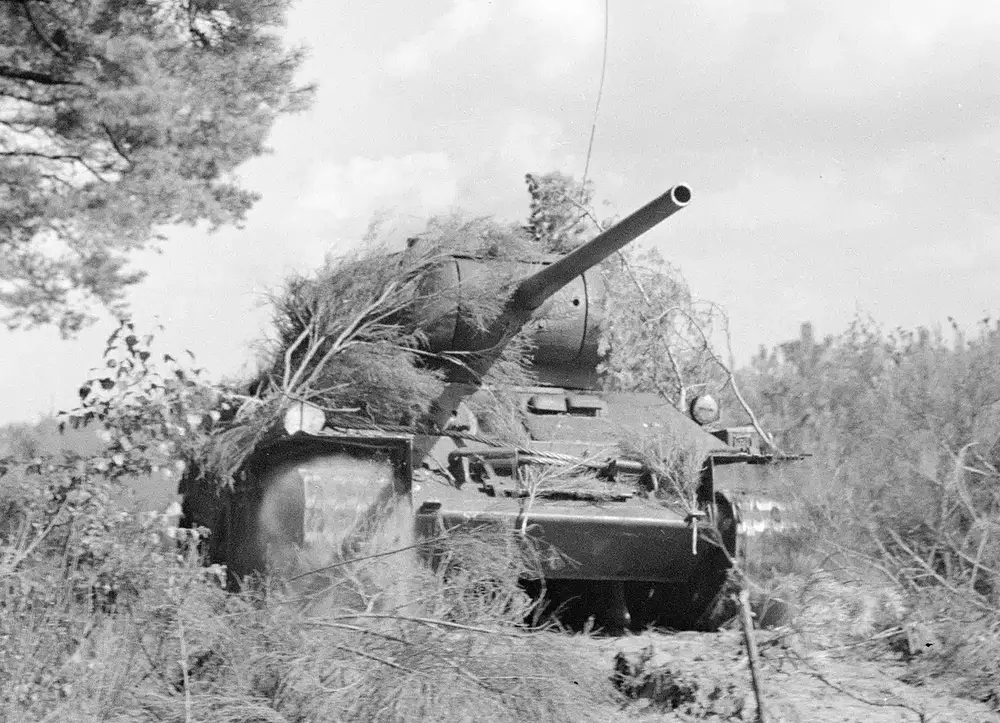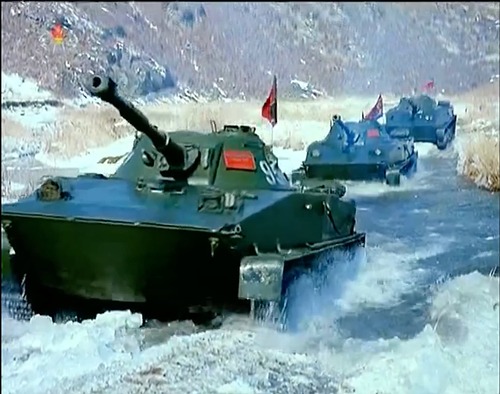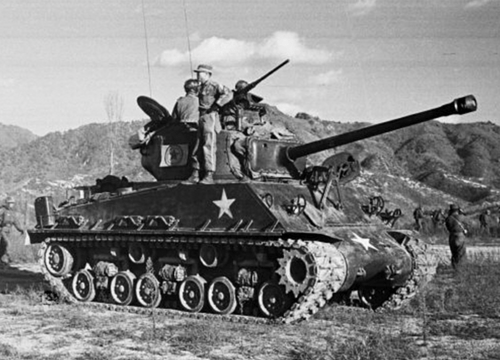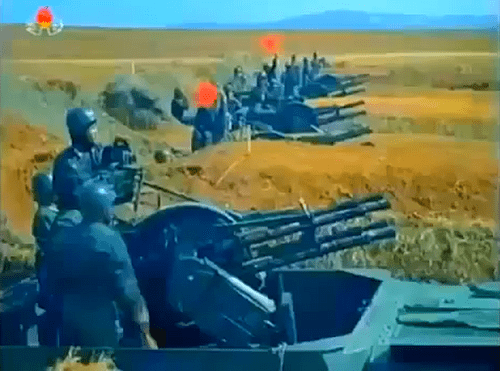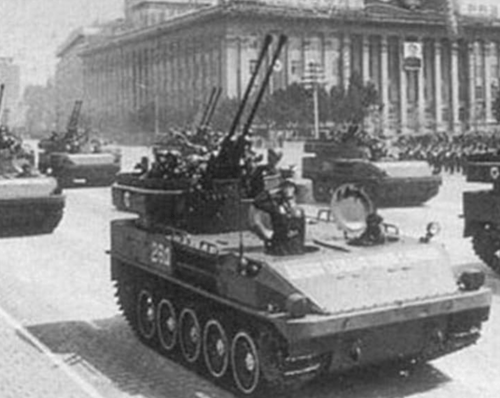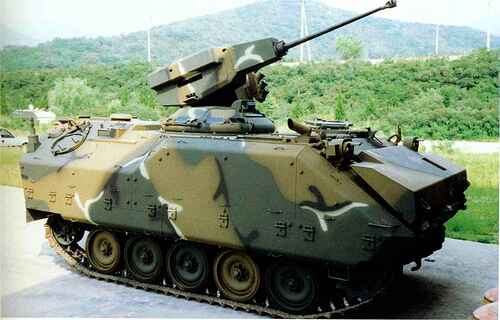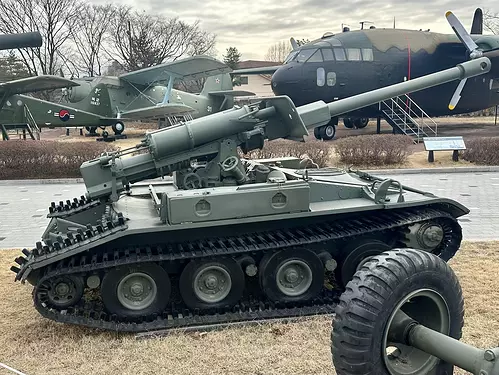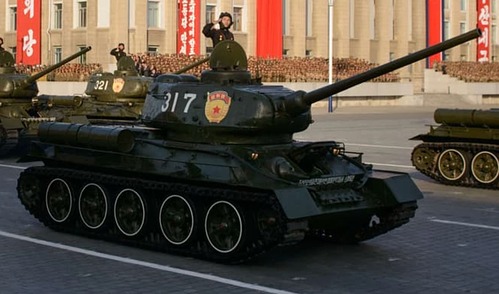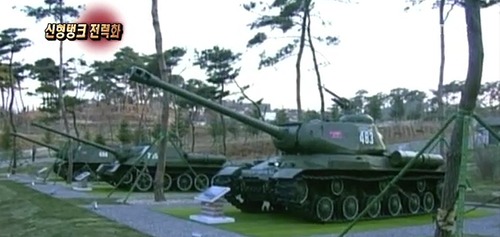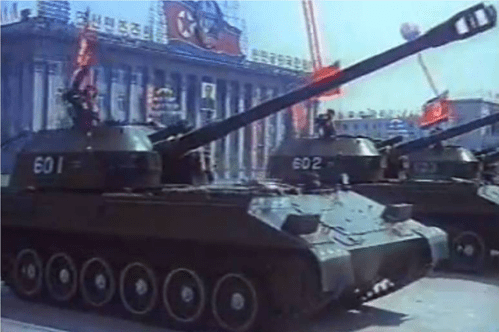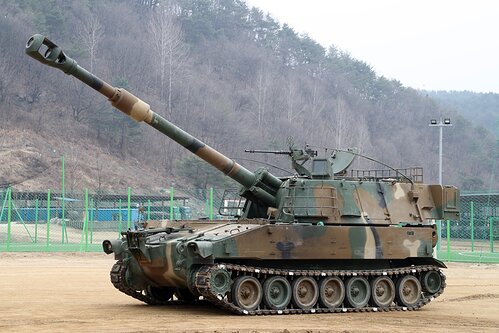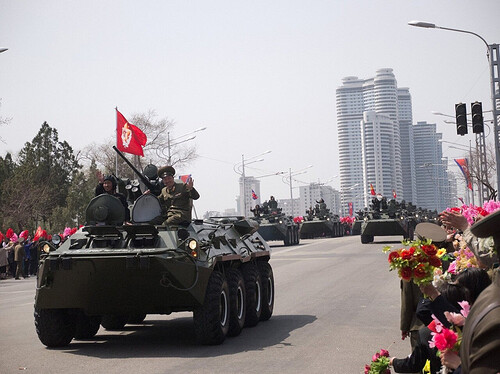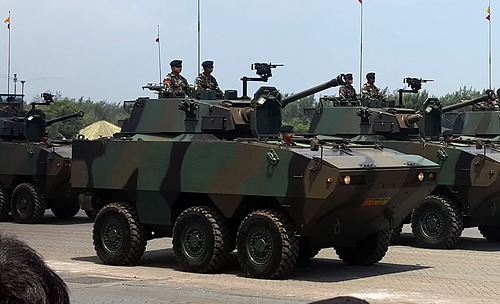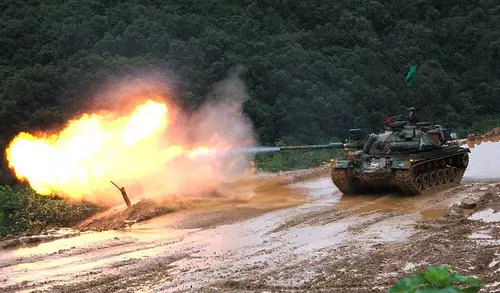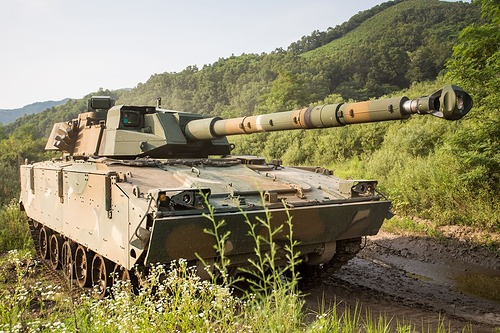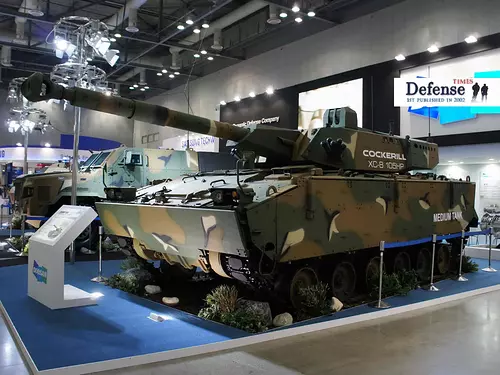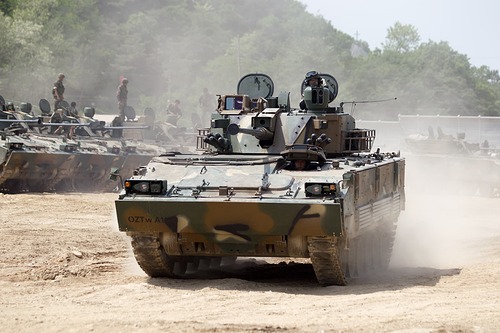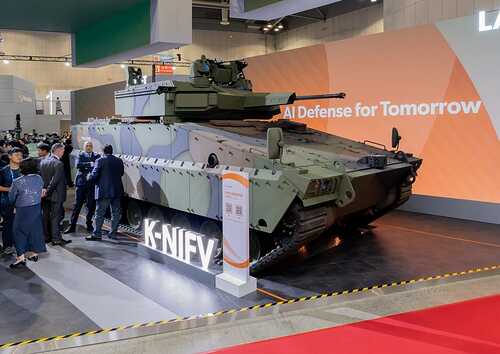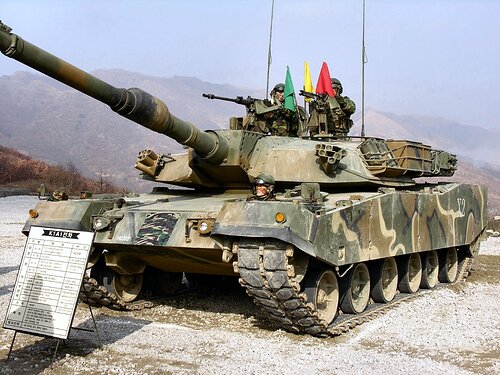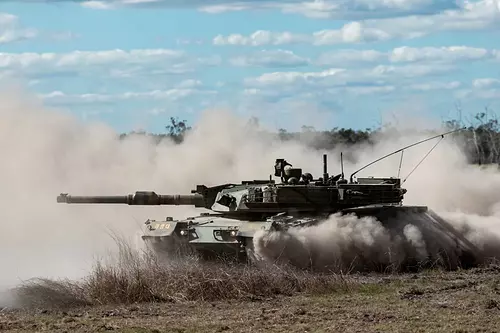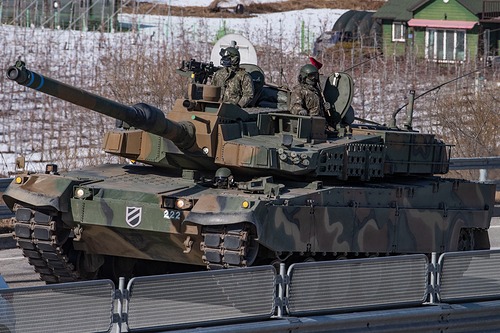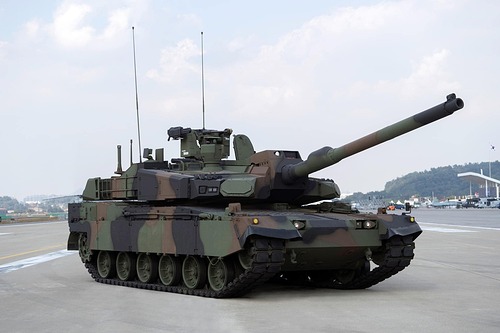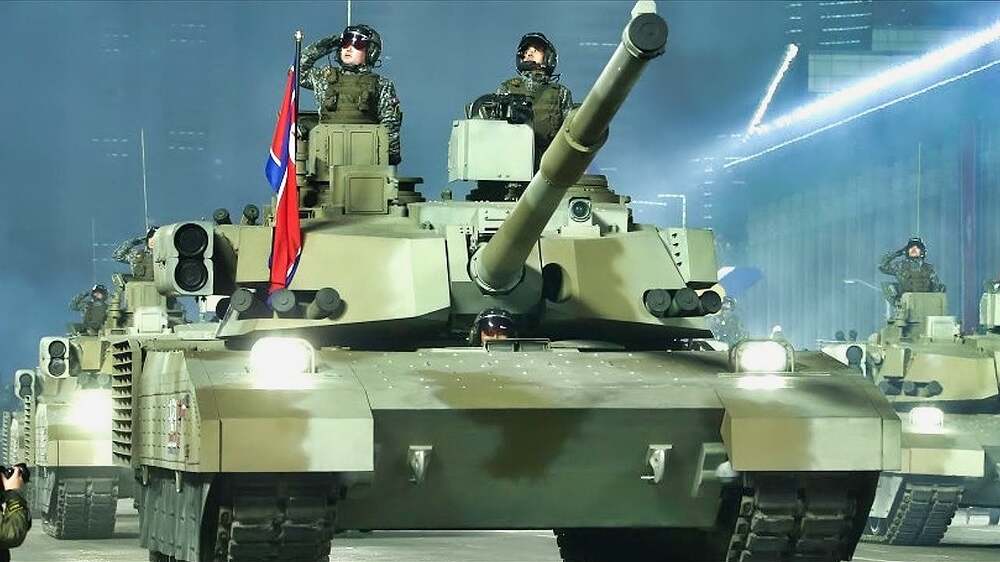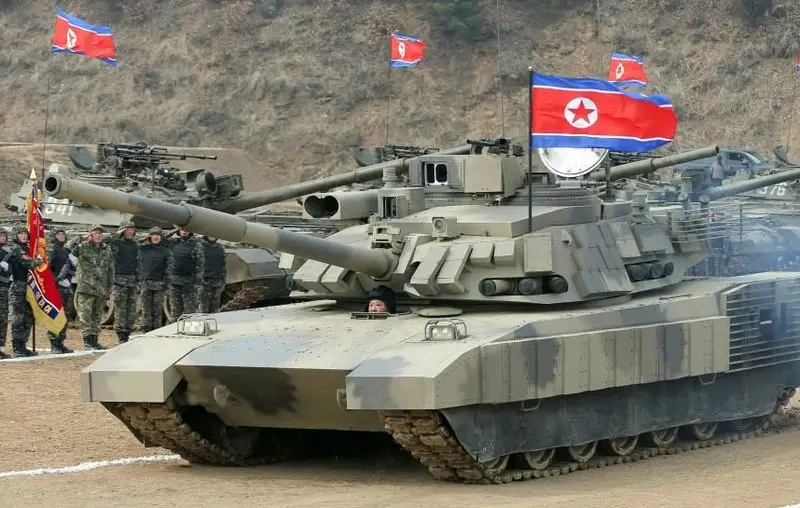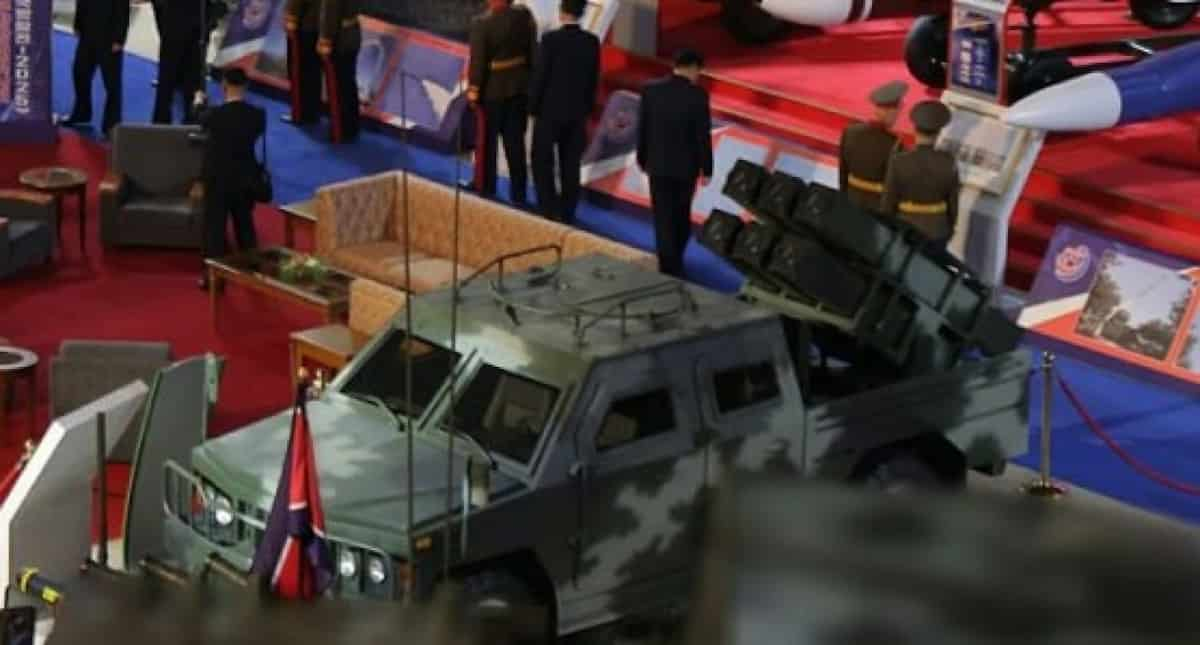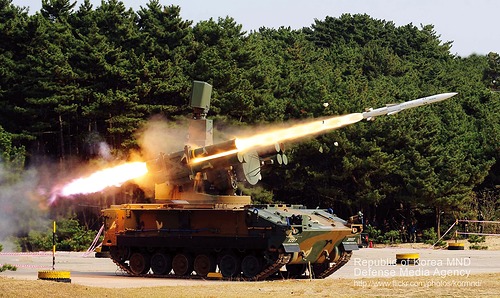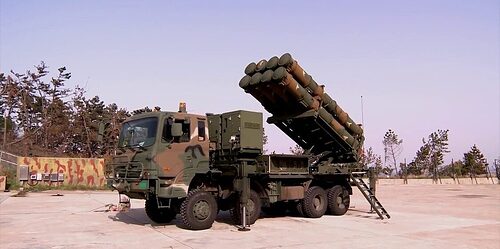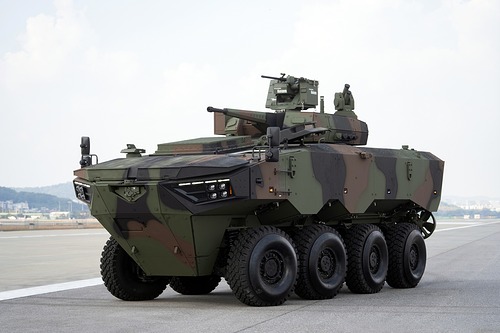Ground Forces Tech Tree
- Yes
- No
Changelog
Version 2.0, 09/11/25
New Vehicles:
- [KP] IS-2 (1944) — BR 6.7.
- [KP] 8x8 FSV (122mm) (2025) — BR 8.7.
- [KP] 323 (9K38) — BR 9.0.
- [KR] K-NIFV — BR 11.0.
- [KP] M2025 4x4 ATGM Carrier — BR 11.3.
- [KP] M2024 8x8 ATGM Carrier — BR 11.7.
- [KR] XK2 FTR — BR 12.3. Squadron Vehicle.
Removed Vehicles:
- [KP / ET] WZ551 (D-30)
- [KP] Tŏkch’ŏn (100mm) (LRF)
- [KR] Tiran 6
- [KP / ER] Ch’ŏnma
- [KP] Ch’ŏnma (1992)
- [KP] Ch’ŏnma-215
- [KP] M1992 (Bulsae-2)
- [KP] M1992 (9K38)
- [KP] M2024 8x8 FSV
- [KR] Black Fox (RCWS-30)
- [KR] Plasan Sandcat
- [KR] KW2 Jupiter
- [KR] K2NO
Renamed Vehicles:
- [KP] 68 → 1968 Heavy Tank
- [KP] 8x8 122mm FSV → 8x8 FSV (122mm)
- [KP] 8x8 ATGM FSV → 8x8 FSV (Bulsae-5)
- [KR] Cheongung (Block-I) → Cheongung
- [KP] Ch’ŏnma-2 (P) → Ch’ŏnma-20 (P)
- [KP] Ch’ŏnma-2 (2024) → Ch’ŏnma-20
- [KP] Chuch’e 107 → Chuch’e 107 155mm SPH
- [KP] Chuch’e-Po (M1989) → Chuch’ep’o
- [KP] Chuch’e-Po (M1991) → M1991
- [KR] K-153C1 → K153C1
- [KR] K21 (CT-CV 105HP) → K21-105 (CT-CV)
- [KR] K21 (XC-8-105) → K21-105 (XC-8)
- [KR] K21 (XC-8-120) → K21-120
- [KR] K263 → K263A1
- [KR] KW1 FSV → Black Fox (CSE 90)
- [KP] M1989 → 30mm SPAAG
- [KP] Nyŏmaeng → Sonyeon
- [KP] PT-76B → 1967 Light Tank
- [KP] Pŏn’gae-3 → Hwasŭngch’ong 10
- [KP] Sinhŭng (2015) → Sinhŭng (2016)
- [KP] Sŏn’gun-915 (2017/2018) → Sŏn’gun-915 (2012/2018)
- [KP] Sonyeon → 323 MLRS (107mm)
- [KR] Tarantula 6x6 → Tarantula 6x6 FSV
- [KP] Tŏkch’ŏn (152mm) (M1974) → 1972 152mm SPH
- [KP] Tŏkch’ŏn (152mm) (M1991) → Tŏkch’ŏn (152mm)
- [KP] Tŏkch’ŏn (122mm) → 1978 122mm SPH
- [KP] Tŏkch’ŏn (130mm) → 1974 130mm SPG
Moved Vehicles (not including between columns):
- Chuch’ep’o: Researchable → Event
- T-34-85 (Late): BR 6.0 → 6.3; Rank III → Rank IV
- Black Fox (CSE 90): BR 7.7 → 7.3
- M113 (M167): BR 7.3 → 7.0
- K263A1: BR 7.7 → 7.3
- Chuch’e 107 155mm SPH: BR 8.0 → 7.7
- Ch’ŏnma-92: Premium → Researchable
- K21: BR 9.7 → 10.3
- K21-105 (XC-8): BR 10.7 → 10.3
- K1A1 (P): Premium → Squadron
- T-80U: BR 11.0 → 11.3; Squadron → Premium
- Ch’ŏnma-20 (P): BR 11.3 → 12.0
- M2020 Short-Range SAM: BR 12.0 → 11.7
- Cheongung: BR 12.0 → 12.7
- Ch’ŏnma-20: BR 12.0 → 12.7
- K2: BR 12.0 → 12.7
- XK2 (KAPS): BR 12.0 → 12.7
- K2EX: BR 12.0 → 12.7
Welcome to this suggestion for a United Korea ground forces tech tree — combining the unique vehicles of both North and South Korea!
The Democratic People’s Republic of Korea (DPRK), more commonly known as North Korea, was founded on 9th September 1948, 3 years after Korea was liberated with the surrender of Imperial Japan and the end of World War 2. Soviet forces entered the North on the 10th August, just four days before Japan announced their surrender. They faced little Japanese resistance, and by 24th August, had reached Pyongyang. During this time, the USSR agreed with the US to divide Korea along the 38th Parallel, and set up independent governments on either side. Despite the existence of the provisional People’s Republic of Korea — a network of decentralised people’s councils — the Soviets began to take control of the councils, incorporating them into their own political structures or infiltrating them with pro-Soviet politicians. On the 8th February 1946, the Provisional People’s Committee of North Korea was formed, with Kim Il Sung as its leader. This transitioned into the fully independent DPRK just two years later.
The Republic of Korea (ROK), more commonly known as South Korea, declared its independence on the 15th August 1948. Unlike the Soviet Union, which pursued a policy of co-optation and indirect military control, the US declared the provisional PRK illegal in December 1945, and ran the country as an official military government. Syngman Rhee was elected president on July 20th 1948. His rule quickly became authoritarian, and led to a number of large-scale protests and uprisings, generating immense amounts of unrest.
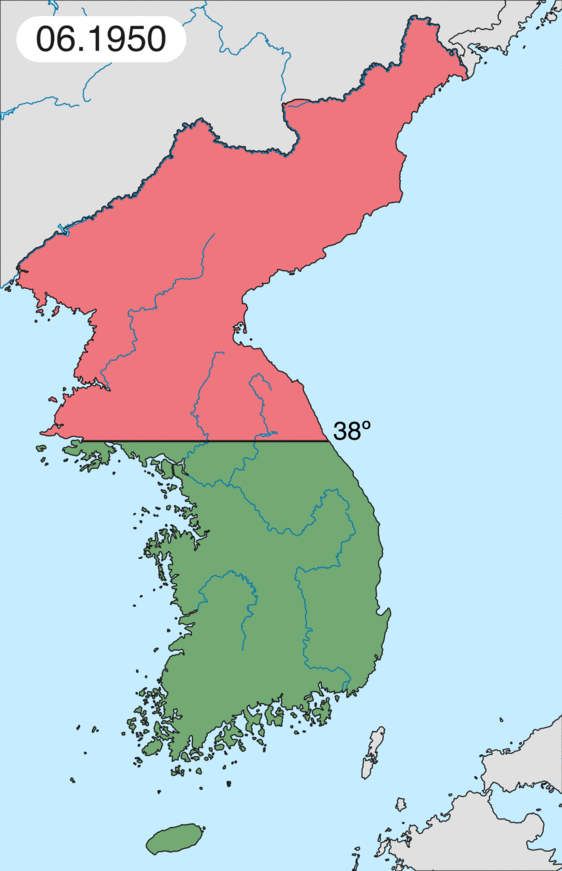
This political instability quickly reached a boiling point on 25th June 1950, when North Korean forces invaded the South. The Korean War saw fierce fighting between North and South Korean forces. The North was supported heavily by Soviet and Chinese troops, and the South by American and UN troops. Anywhere from 1.6–4 million civilians and hundreds of thousands of soldiers died in just three years. An armistice was signed on 27th July 1953, ordering a ceasefire and the establishment of the Demilitarised Zone (DMZ). The two states have been in a frozen conflict since, occasionally engaging in border skirmishes, with no official peace treaty in sight.
The Korean People’s Army (KPA) was initially armed with large numbers of Soviet equipment, including tanks, enabling the initial rapid takeover of much of the South, which had very little in comparison. Post-war, North Korea received large numbers of T-54s/55s from the USSR and Type 59s from China. Domestic production began in the late 1960s with copies of the PT-76B and T-54/55, and in the 1970s, switched to the T-62. The T-62, designated Ch’ŏnma, would go on to form the basis of most of the DPRK’s domestic MBTs, as would a delivery of a single T-72, enabling the isolated country to develop more modern vehicles like the Sŏn’gun-915 and their most recent, the Ch’ŏnma-20. North Korea also produced copious numbers of SPGs, numbering in the thousands, and has done so since the early 1970s.
The Republic of Korea Army (ROKA), as stated above, was initially poorly-equipped. However, during the war they began to receive US equipment and vehicles, including M4 Shermans and M36 Jacksons. Post-war, South Korea’s army was in a poorer shape than the neighbouring KPA, equipped with some US leftovers, but nothing to constitute a genuine threat to the North. This began to change with the delivery of M48 Pattons, but North Korea’s Ch’ŏnma produced around the same time was on part with or better than them. However, things really started to change with the domestic M48 upgrade program, as well as the development of the K1 — instantly outclassing the North’s Ch’ŏnma-92 produced around the same time. The K1 would undergo a number of upgrades, including equipping it with a 120mm cannon, similar to uprades done on the M1 Abrams, from which the K1 is derived. The K2 was produced in the early 2000s — the ‘Black Panther’ is one of the world’s best production MBTs, and has been produced in large numbers. North Korea’s Ch’ŏnma-20 is a step in the right direction to countering the K2, but is more than likely still outmatched.
A Korean Tech Tree has been popular for years within the community. It presents an opportunity for a large, unique, and highly diverse ground forces tree, combining the best of Western and Soviet designs.
On the old forum, the United Korea ground forces tree made in 2019 was passed to the developers. In a December 2021 Q&A, the developers hinted at the addition of a United Korean tree in the same style as Israel (i.e. not starting at Rank 1). And — most importantly and recently — a United Korean tech tree was confirmed to be in the works in October 2025, to be added at an unspecified time.
This proposal seeks to show the potential a United Korean tree has, while remaining realistic — I have not included every possible vehicle, and I have followed Gaijin’s rules for adding vehicles as best as I can. I have also attempted to reduce copy-paste, to hopefully add as many domestically designed or modified vehicles as possible.
As of 09/11/2025, this tree has 101 vehicles, of which:
- 16 are direct copy-paste (16%)
- 4 are vehicles in-game but with some minor modifications or model changes (4%)
- 1 are imported vehicles not yet in-game (1%)
- 80 are unique, domestic vehicles or modifications (79%)
And:
- 53 are South Korean (52%)
- 48 are North Korean (48%)
And:
- 57 have individual suggestion posts (56%)
I hope you give this suggestion support, and help inform the developers on what the community wants to see from a Korean tech tree!
Spoiler
Rank III
Line 1 – Light Tanks, FSVs, and IFVs
☯︎ M24
M24 Chaffee
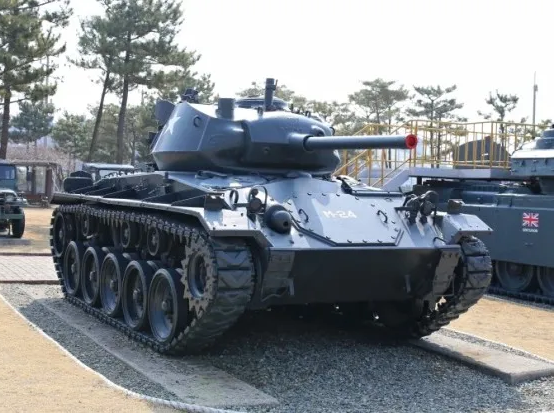
The M24 Chaffee was the first US tank to see combat in the Korean War, although they suffered heavy losses against the North’s T-34-85s. They were quickly replaced by M4A3E8s in the combat role. In late 1952, South Korea received 22 M24s from the US, which were used for training purposes. All were later transferred to the Taiwanese Army.
BR 3.7. Reserve.
Armament: 75mm M6
Mobility: 296hp, 56km/h
Armour: 25/25/19mm hull; 25/25/25mm turret
✪ 1967 Light Tank
1967-model amphibious light tank
The Soviet PT-76B was developed in 1959, as an upgraded variant of the PT-76. It notably featured a stabiliser and a new engine. Around 100 PT-76Bs were reportedly delivered to North Korea from 1965–1967. According to North Korea, they began domestic production of the PT-76B in 1967 (although the first vehicles produced were likely assembled from knock-down kits, with actual production starting sometime in the 1970s). An unknown number are in service. A number of APCs and light tanks have been developed by North Korea with inspiration and technology from the PT-76B.
BR 5.3.
Armament: 76mm D-56TS
Mobility: 240hp, 44km/h
Armour: 13/13/6mm hull; 15/15/15mm turret
Line 2 – South Korean Medium Tanks and MBTs
☯︎ M4A3 (76) W
M4A3 (76) W Sherman
The M4A3E8 — or M4A3 (76) W — saw heavy usage during the Korean War. The first 58 were deployed by the US on the 1st August 1950. Over 600 would be deployed during the war. The South Korean Marine Corps (ROKMC) received 20 in 1951, and they saw service alongside the M36. In 1954, 388 were transferred to the South Korean Army.
BR 5.7.
Armament: 76mm M1
Mobility: 500hp, 42km/h
Armour: 63/38/38mm hull; 63/63/63mm turret
☯︎ M36 (Late)
M36 GMC (Late)

The M36 was widely used during the Korean War. The US supplied the South with 216 M36s. These included modernised M36s and M36E9s, but contrary to popular belief, no M36B2s. One of these same modernised variants was sent to Japan (which is the variant seen in-game). In Korean service, the M36 was classified as a tank — not a tank destroyer. They were taken out of active service in 1959.
BR 5.7.
Armament: 90mm M3A1
Mobility: 500hp, 48km/h
Armour: 38/19/19mm hull; 76/31/25mm turret
Line 3 – North Korean Medium Tanks and MBTs
✪ T-34 (1941)
T-34 (1941)

The T-34 was North Korea’s first tank, and was used to great effect from the very start of the Korean War. South Korean forces initially stood no chance against North Korean T-34s and SU-76s. At the start of the war, North Korea operated an unknown number of T-34-76s (1941, 1942, and 1943 variants), alongside 258 T-34-85s, followed by additional deliveries later on. After the war, North Korea received an estimated 1000 T-34s (likely all T-34-85s) from the USSR. The few T-34-76s that did survive the war remained in service for decades, still being spotted in exercises as late as 2012, although they are, along with the remaining T-34-85s, likely to be in service only with the Worker-Peasant Red Guards or in reserve.
BR 4.0. Reserve.
Armament: 76mm F-34
Mobility: 500hp, 49km/h
Armour: 45/45/40mm hull; 45/45/45mm turret
✪ T-34 (1942)
T-34 (1942)

Vehicle at the back
The T-34 was North Korea’s first tank, and was used to great effect from the very start of the Korean War. South Korean forces initially stood no chance against North Korean T-34s and SU-76s. At the start of the war, North Korea operated an unknown number of T-34-76s (1941, 1942, and 1943 variants), alongside 258 T-34-85s, followed by additional deliveries later on. After the war, North Korea received an estimated 1000 T-34s (likely all T-34-85s) from the USSR. The few T-34-76s that did survive the war remained in service for decades, still being spotted in exercises as late as 2012, although they are, along with the remaining T-34-85s, likely to be in service only with the Worker-Peasant Red Guards or in reserve.
BR 4.0. Foldered with T-34 (1941).
Armament: 76mm F-34
Mobility: 500hp, 49km/h
Armour: 45/45/40mm hull; 53/53/53mm turret
✪ T-34-85
T-34-85

The T-34 was North Korea’s first tank, and was used to great effect from the very start of the Korean War. South Korean forces initially stood no chance against North Korean T-34s and SU-76s. At the start of the war, North Korea operated an unknown number of T-34-76s (both 1941 and 1942 variants), alongside 258 T-34-85s, followed by additional deliveries later on. After the war, North Korea received an estimated 1000 T-34s (likely all T-34-85s) from the USSR. These remained North Korea’s primary tank up until the delivery of T-54/55s and Type 59s from the USSR and China, which began in the late 1950s. The T-34-85 remained in frontline service alongside these vehicles, gradually being replaced — 400–650 were in service in the mid 1980s. Most have since been taken out of active service, and are likely to be in service only with the Worker-Peasant Red Guards or in reserve.
BR 5.7.
Armament: 85mm ZIS-S-53
Mobility: 500hp, 55km/h
Armour: 45/45/45mm hull; 90/75/52mm turret
Line 4 – Tank Destroyers and ATGM Carriers
✪ 1972 152mm SPH
1972-model 152mm self-propelled howitzer
Suggestion Post
North Korea acquired the Soviet ATS-59 artillery tractor sometime in the 1960s. A large number of self-propelled guns have been created on modified ATS-59 chassis, which are frequently referred to under the name Tŏkch’ŏn — this is not an official name. Construction of most of these took place in the 1970s. One of the first models produced is designated 1972-model 152mm SPH in North Korea, and is referred to as ‘M1974’ by Western sources (based on when it was first spotted). This vehicle is fitted with a domestically-modified 152mm D-20 (new muzzle-brake). It has been widely produced, and is one of the DPRK’s most common tracked artillery pieces.
BR 4.0.
Armament: 152mm D-20 (mod.)
Mobility: 300hp, 39km/h
Armour: None.
☯︎ K105A1
K105A1
The K105A1 is a South Korean truck-based SPG. The first prototype was built in 2011, and it entered serial production in 2018 — 850 have since been produced. It features a rear-mounted 105mm M101A1 howitzer, a domestic variant of the US M101. This gun is capable of firing HEAT rounds capable of penetrating up to 183mm of armour at 10 rpm.
BR 4.7.
Armament: 105mm M101A1
Mobility: 270hp, 88km/h
Armour: None.
✪ 1978 122mm SPH
1978-model 122mm self-propelled howitzer
Suggestion Post
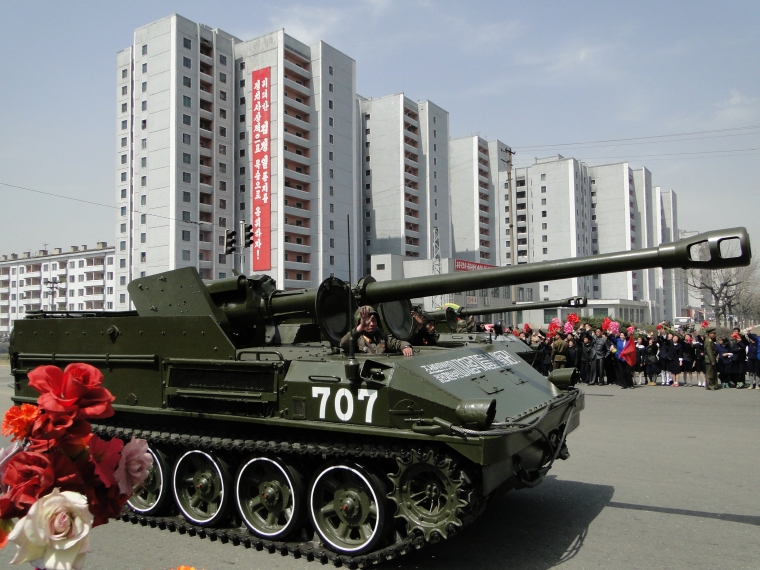
North Korea acquired the Soviet ATS-59 artillery tractor sometime in the 1960s. A large number of self-propelled guns have been created on modified ATS-59 chassis, which are frequently referred to under the name Tŏkch’ŏn — this is not an official name. Construction of most of these took place in the 1970s. The penultimate model produced is designated 1978-model 122mm SPH in North Korea, and is referred to as ‘M1981’ by Western sources (based on when it was first spotted). This vehicle is fitted with a domestic 122mm cannon based on the D-74. It has been relatively widely produced, and is seen regularly.
BR 5.0.
Armament: 122mm D-74 (mod.)
Mobility: 300hp, 39km/h
Armour: None.
Line 5 – SPAA
✪ 323 (14.5mm)
323 (14.5mm)
Suggestion Post
The 323 — officially the 1973-model armoured personnel carrier 323 — is a domestic North Korean APC, produced since 1973, derived from the Chinese Type 63 / YW531A. It has been produced in huge numbers, and although in its most basic form features a turret with dual 14.5mm KPV HMGs, has been used as the basis for a number of different vehicles, including SPAA and SPGs. One such example of this is the 323 (14.5mm), fitted with a ZPU-4 (known in North Korea as Type-64). The production year is unknown — an up-armoured variant is designated ‘M1983’ in Western sources.
BR 4.0.
Armament: 14.5mm ZPU-4
Mobility: 320hp, 60km/h
Armour: 12/8/8mm hull
✪ Tŏkch’ŏn (37mm)
Tŏkch’ŏn (37mm)
Suggestion Post
North Korea acquired the Soviet ATS-59 artillery tractor sometime in the 1960s. A large number of self-propelled guns have been created on modified ATS-59 chassis, which are frequently referred to under the name Tŏkch’ŏn — this is not an official name. Construction of most of these took place in the 1970s. Alongside these SPGs, one SPAA was created, which is referred to as ‘M1978’ in Western sources (and also sometimes K-37-2). It features two 37mm Type 65 cannons in a rear-mounted turret, similar in silhouette to the ZSU-37 or M19 MGMC (which North Korea captured multiple examples). It was produced in few numbers, and was replaced in the 1980s by the ‘M1989’ 30mm SPAAG.
BR 4.7.
Armament: 2x 37mm Type 65
Mobility: 300hp, 39km/h
Armour: None (at least on the hull; turret may have 10–15mm armour).
☯︎ KAFV-30M
Korean Armoured Fighting Vehicle-30M
Suggestion Post
The Korean Armoured Fighting Vehicle (KAFV) program began in the mid-1990s, in an attempt to modernise the K200 KIFV, primarily for the export market. Four prototypes were built and tested in 1995, all with a different turret and armament. One of these was the KAFV-30M, fitted with an unmanned turret housing a 30mm autocannon. Although it could optionally be stabilised and feature APFSDS rounds, it would be best suited in this tree as an SPAA.
BR 5.7.
Armament: 30mm Mauser MK 30
Mobility: 350hp, 70km/h
Armour: Hull resists 12.7mm frontally and across sides.
Rank IV
Line 1 – Light Tanks, FSVs, and IFVs
✪ 323 (85mm)
323 (85mm)
Suggestion Post
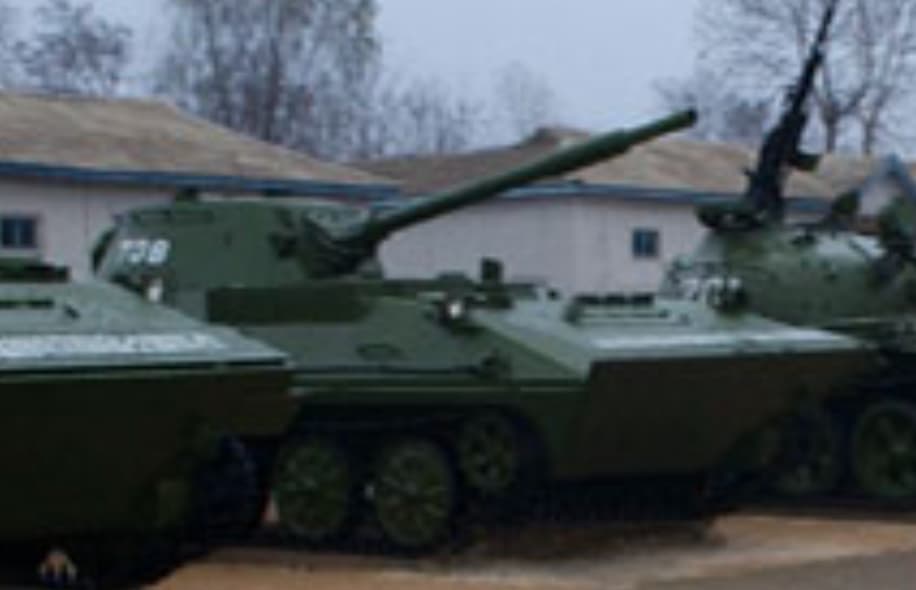
The 323 — officially the 1973-model armoured personnel carrier 323 — is a domestic North Korean APC, produced since 1973, derived from the Chinese Type 63 / YW531A. It has been produced in huge numbers, and although in its most basic form features a turret with dual 14.5mm KPV HMGs, has been used as the basis for a number of different vehicles, including SPAA and SPGs. One light tank variant was produced, of which little is known. It features an 85mm cannon, derived from the Chinese Type 63 on the Type 62 and 63 light tanks, in a turret similar to that of the PT-76. An intelligence report notes that production of a 30-to–37mm IFV entered production in 1984, although it describes a vehicle very similar to this light tank (and North Korea has not produced any known domestic IFVs). It has been seen very infrequently, and was likely a limited production run before the ‘M1985’ Sinhŭng.
BR 6.3.
Armament: 85mm Type 63 (mod.)
Mobility: 320hp, 60km/h
Armour: 12/8/8mm hull; 15/15/15mm turret
✪ Sinhŭng (2016)
1981-model light tank Sinhŭng
Suggestion Post
The Sinhŭng is a domestic North Korean light tank, supposedly developed in 1981, and often referred to as ‘M1985’ or ‘PT-85’ in Western sources. It features a new chassis, based on the 323 but modified and lengthened, with a turret similar to that of the PT-76, but armed with a domestic 85mm cannon, derived from the Chinese Type 63 85mm cannon. It was first revealed publicly in the parade in 1985. In 2016, they were displayed with a few upgrades, including smoke grenade launchers and a rear-mounted 9K38 Igla launcher. Estimates suggest around 500 have been built, and they remain North Korea’s best light tank.
BR 6.7.
Armament: 85mm (domestic)
Mobility: 320hp, 60km/h
Armour: Unknown, likely 10–20mm all around.
☯︎ M56
M56 Scorpion
The M56 is an American light airborne tank destroyer, produced since 1953. 325 were built, and they saw service primarily with US forces, including during the Vietnam War. South Korea received around 60 M56 Scorpions from US forces stationed in the country at some point in the mid-1960s. They were not operated for long before — presumably — being scrapped. At least one remains on display in a museum in South Korea.
BR 6.7.
Armament: 90mm M54
Mobility: 200hp, 45km/h
Armour: 0/0/0mm hull; 5/0/0mm turret
Line 2 – South Korean Medium Tanks and MBTs
☯︎ M46
M46 Patton
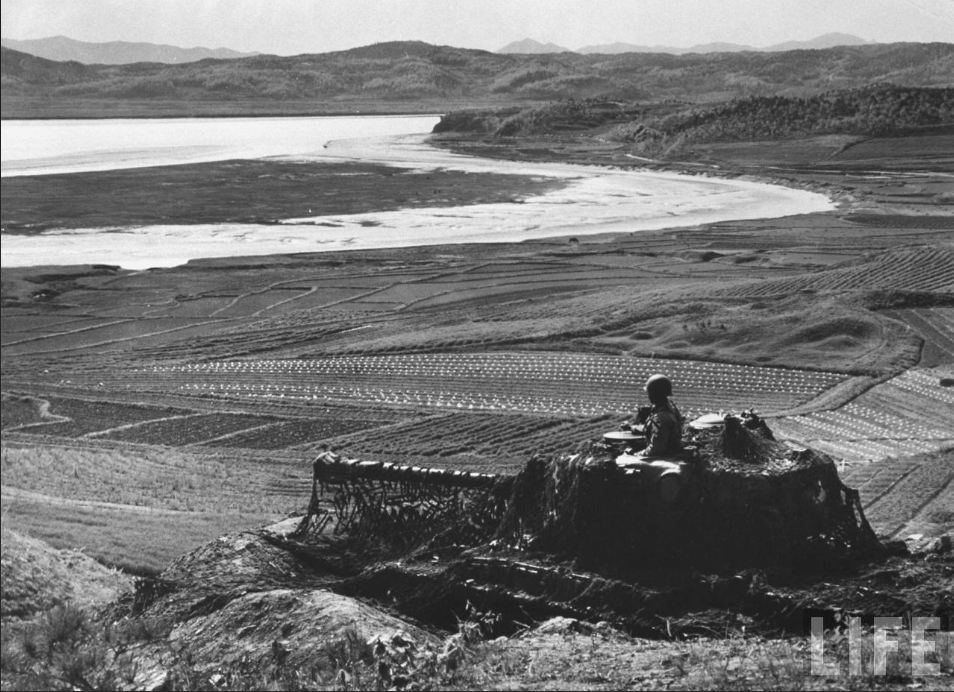
The M46 Patton is a US medium tank, well-known for its use in the Korean War. The M46 featured a number of improvements over the older M26, with an improved main gun and power pack. After the war ended in 1953, a small (and unknown) number of M46s were transferred to the South Korean army. These were used for training and stationed in dugouts, and presumably were scrapped in the early 1970s.
BR 7.0.
Armament: 90mm M3A1
Mobility: 810hp, 48km/h
Armour: 101/76/50mm hull; 101/76/76mm turret
Line 3 – North Korean Medium Tanks and MBTs
✪ T-34-85 (Late)
T-34-85 (Late)
Suggestion Post
The T-34 was North Korea’s first tank, and was used to great effect from the very start of the Korean War. South Korean forces initially stood no chance against North Korean T-34s and SU-76s. At the start of the war, North Korea operated an unknown number of T-34-76s (both 1941 and 1942 variants), alongside 258 T-34-85s, followed by additional deliveries later on. After the war, North Korea received an estimated 1000 T-34s (likely all T-34-85s) from the USSR. These remained North Korea’s primary tank up until the delivery of T-54/55s and Type 59s from the USSR and China, which began in the late 1950s. The T-34-85 remained in frontline service alongside these vehicles, gradually being replaced — 400–650 were in service in the mid 1980s. These T-34-85s were upgraded multiple times, beginning with new starfish roadwheels in the 1970s, followed by new tracks and sprocket wheels, as well as mounting points for slat-armour, among others. While the exact ammunition used by North Korea is unknown, the 85mm is compatible with post-war HEAT-FS rounds, which easily could have been acquired by North Korea. Most T-34-85s have since been taken out of active service, and are likely to be in service only with the Worker-Peasant Red Guards or in reserve.
BR 6.3.
Armament: 85mm ZIS-S-53
Mobility: 500hp, 55km/h
Armour: 45/45/45mm hull; 90/75/52mm turret
✪ IS-2 (1944)
IS-2 (1944)
The IS-2 saw service during the Korean War with Chinese forces, although they were likely all stationed close to the Sino-Korean border, and used primarily for training. Reports suggest that post-war, North Korea was supplied with 12 IS-2s from the USSR. Although this claim is fairly pervasive, it remains largely unverified. At least one IS-2 is located in a museum in Pyongyang, although whether it actually saw service with North Korea is uncertain.
BR 6.7.
Armament: 122mm D-25T
Mobility: 520hp, 37km/h
Armour: 100/90/60mm hull; 100/100/100mm turret
Line 4 – Tank Destroyers and ATGM Carriers
✪ Tŏkch’ŏn (100mm)
Tŏkch’ŏn (100mm)
Suggestion Post

North Korea acquired the Soviet ATS-59 artillery tractor sometime in the 1960s. A large number of self-propelled guns have been created on modified ATS-59 chassis, which are frequently referred to under the name Tŏkch’ŏn — this is not an official name. Construction of most of these took place in the 1970s. One of the first models produced is referred to as ‘M1972’ by Western sources (based on when it was first spotted; official name unknown). This vehicle is fitted with a 100mm anti-tank cannon, commonly referred to as a D-10 or D-10 derivative — however, it more closely resembles the Romanian M1977 / A407. Although the A407 was first produced in 1975, North Korea and Romania are known to have had shared military technology during the Cold War, lending some possibility to the A407 being partially designed by North Korea. It is also possible that the production vehicles feature an A407-derivative, after Romanian deliveries in the mid-1970s, unlike the vehicle(s) spotted in 1972, which may have featured different guns. Alternatively, it is possible that the 1972 date is inaccurate, as I can’t actually find a primary source for this designation.
BR 6.0.
Armament: 100mm A407 mod. (?)
Mobility: 300hp, 39km/h
Armour: None.
✪ M1991
M1991
Suggestion Post
The ‘M1991’ is a relatively unknown domestic North Korean SPG. The name Chuch’ep’o is sometimes ascribed to this vehicle and another similar one (‘M1992’), but this is likely to be confusion with the 170mm Chuch’ep’o and not the official name. It features a domestic 122mm cannon derived from the D-74 — the same as the 1978-model 122mm SPH — in a turret, on a new chassis with six roadwheels. It appears to be derived from the Ch’ŏnma, and is similar to that of the Ch’ŏnma-216 — however, it lacks the return rollers present on the -215/216. Seeing as it was likely under development in the late 1980s, work on this chassis may have served as a crucial stepping stone for the more refined six-roadwheel design on the later MBTs. The overall design of the ‘M1991’ is very reminiscent of the Soviet 2S1 and 2S3. It has been seen infrequently, although appears to have entered into (perhaps limited) production.
BR 6.0.
Armament: 122mm D-74 (mod.)
Mobility: 580hp, 50km/h
Armour: Unknown. Likely <30mm all around.
✪ 1974 130mm SPG
1974-model 130mm self-propelled level-fire gun
Suggestion Post

North Korea acquired the Soviet ATS-59 artillery tractor sometime in the 1960s. A large number of self-propelled guns have been created on modified ATS-59 chassis, which are frequently referred to under the name Tŏkch’ŏn — this is not an official name. Construction of most of these took place in the 1970s. Two 130mm models were produced, one of which is designated 1974-model 130mm SPG in North Korea, and is referred to as ‘M1991’ or ‘M1992’ by Western sources (based on when it was first spotted). This vehicle is turreted, unlike most vehicles in this family, and is fitted with a 130mm cannon derived from the Soviet M-46 and fitted with the muzzle-brake of the SM-4-1.
BR 6.3. Foldered with M1991.
Armament: 130mm M-46 (mod.)
Mobility: 300hp, 39km/h
Armour: None (at least on the hull; turret will have more armour, but unknown thickness).
☯︎ K55
K55
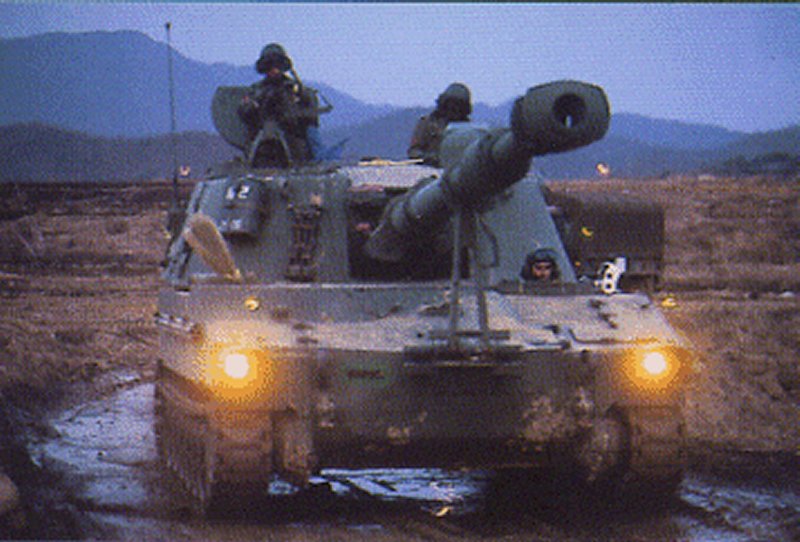
The K55 is the South Korean designation for license-produced M109A2. License-production began in 1985, in an attempt to replace the aging M107 and M110s. 1,180 K55s were produced by 1996, serving as one of South Korea’s most numerous SPGs. All K55s have since been upgraded to the K55A1 model.
BR 6.3.
Armament: 155mm M185
Mobility: 405hp, 56km/h
Armour: 32/32/32mm hull; 32/32/32mm turret
☯︎ K55A1
K55A1
The K55 is the South Korean designation for license-produced M109A2. License-production began in 1985, in an attempt to replace the aging M107 and M110s. 1,180 K55s were produced by 1996, serving as one of South Korea’s most numerous SPGs. The K55A1 is an upgrade to the K55, featuring the K9’s electronics and FCS, as well as a semi-automatic loader, substantially improving the vehicle’s rate of fire. All K55s had been upgraded to K55A1 standard by the end of 2022.
BR 6.7. Foldered with K55.
Armament: 155mm M185
Mobility: 405hp, 56km/h
Armour: 32/32/32mm hull; 32/32/32mm turret
Line 5 – SPAA
✪ M1985
M1985
Suggestion Post

The ‘M1985’ (official designation unknown) is a North Korean SPAA, likely developed in the late-1970s or early-1980s. It features a domestically-produced (and slightly modified) GMZ-575 chassis, the same type as the ZSU-23-4. North Korea received a few of these vehicles in the early 1970s, which likely kickstarted the development of this SPAA (and the later ‘M1989’). The ‘M1985’ features a very boxy turret, fitted with two 57mm S-68A anti-aircraft guns, in a very similar configuration to the ZSU-57-2 (which, despite reports, North Korea almost certainly never received or operated). One prominent downside to the ‘M1985’ is its lack of gun depression, limited to about +1°, reducing it to a purely anti-aircraft role.
BR 6.7.
Armament: 57mm S-68A
Mobility: 280hp, 50km/h
Armour: 9/9/7mm hull; Unknown turret (<15mm)
Rank V
Line 1 – Light Tanks, FSVs, and IFVs
☯︎ KAFV-90
Korean Armoured Fighting Vehicle-90
Suggestion Post

The Korean Armoured Fighting Vehicle (KAFV) program began in the mid-1990s, in an attempt to modernise the K200 KIFV, primarily for the export market. Four prototypes were built and tested in 1995, all with a different turret and armament. One of these was the KAFV-90, fitted with a Cadillac Gage two-man turret housing a 90mm Cockerill Mk. III M-A1 cannon, capable of firing HEAT-FS and APFSDS rounds (although at 7.0, should just have HEAT-FS).
BR 7.0.
Armament: 90mm Cockerill Mk. III M-A1
Mobility: 350hp, 70km/h
Armour: Hull resists 12.7mm frontally and across sides. Turret unknown.
✪ BTR-80A
BTR-80A
The BTR-80A was developed by Russia in the early 1990s. It was fitted with a 30mm 2A72 autocannon on the BTR-80 hull, turning it into an IFV. Russia built 200, before replacing them with the upgraded BTR-82A in the early 2010s. North Korea received 32 BTR-80As in 2001. They remain North Korea’s only dedicated IFV. The delivery of these vehicles very likely aided in the development of North Korea’s own APC variant, the ‘M2010’ in both 6x6 and 8x8 variants.
BR 7.3.
Armament: 30mm 2A72
Mobility: 260hp, 87km/h
Armour: 12/8/6mm hull; 23/23/13mm turret
☯︎ Tarantula 6x6 FSV
Tarantula 6x6 Fire Support Vehicle
Suggestion Post
The Tarantula 6x6 FSV is a joint South Korean—Indonesian wheeled vehicle. The South Korean company Doosan developed the Black Fox APC in 2003, initially designed for the South Korean army. It lost the competition, and was subsequently advertised to export customers. In 2009, Doosan signed a contract with Indonesia to produce 43 Black Fox APCs fitted with a CSE 90LP turret housing a 90mm Cockerill cannon — named the Tarantula. The total number was reduced to 22 after some modifications, and half were built in South Korea, and the other half in Indonesia. The tank features a stabilised cannon, a laser rangefinder, and thermal sights.
BR 7.7.
Armament: 90mm Cockerill Mk. III M-A1
Mobility: 400hp, 100km/h
Armour: Unknown hull; Turret resists 7.62mm
Line 2 – South Korean Medium Tanks and MBTs
☯︎ M47
M47 Patton
The M47 Patton is an American medium tank that entered production in 1951. It improved on its predecessor, the M46, in a number of ways — primarily featuring a new turret and UFP design. The M47 saw very limited service in the Korean War with US forces. South Korea received 531 M47s from the US from 1959–1964. They remained in service until the mid-2000s.
BR 7.3.
Armament: 90mm M36
Mobility: 810hp, 48km/h
Armour: 101/76/60mm hull; 121/63/76mm turret
☯︎ M48A3K
M48A3K Patton
Beginning in the mid-1960s, South Korea began to receive large numbers of M48 Pattons — namely the M48A1 and M48A2C. Close to 1,100 were acquired. In the late 1970s, development of two separate upgrades began. Upgrades to the M48A1 (and some M48A2Cs) brought them to M48A3-standard — these were called M48A3K. They featured a new engine and a new FCS, including a laser rangefinder. They retained the old 90mm cannon, but South Korea have developed a 90mm APFSDS round (K241), capable of penetrating ~245mm @ 0° @ 0m. They were fully retired in 2022.
BR 8.0.
Armament: 90mm M41
Mobility: 810hp, 48km/h
Armour: 110/76/25mm hull; 130/76/51mm turret
Line 3 – North Korean Medium Tanks and MBTs
✪ T-54 (1951)
T-54 (1951)
North Korea first received the T-54 in the mid-1950s, consisting of both the T-54 (1949) and T-54 (1951) variants. In the 1960s, North Korea received substantially more — including various models of T-54/55s from the USSR, and Type 59s from China. North Korea would also go on to domestically produce the T-55, under the name ‘1968-model heavy tank’ in 1968 (according to North Korea; South Korean sources say that production began in 1973). Almost all T-54/55s/Type 59s have been fitted with provisions for slat armour across the vehicles’ sides, and this could be added as a researchable module.
BR 8.0.
Armament: 100mm D-10T
Mobility: 520hp, 50km/h
Armour: 100/80/45mm hull; 200/160/65mm turret
✪ 1968 Heavy Tank
1968-model heavy tank
North Korea first received the T-54 in the mid-1950s, consisting of both the T-54 (1949) and T-54 (1951) variants. In the 1960s, North Korea received substantially more — including various models of T-54/55s from the USSR, and Type 59s from China. North Korea would then go on to domestically produce the T-55, under the name ‘1968-model heavy tank’ in 1968 — as they claim. However, South Korean sources suggest that production actually began in 1973, and there is reason to believe that the vehicles produced were actually mostly T-54s or Type 59s, having switched over after relatively small numbers of T-55s were produced. The 1968 heavy tank can be identified by its roof-mounted 14.5mm KPV machine gun. Later upgrades include provisions for slat armour, smoke grenades, and a rear-turret mounted HT-16PGJ (Igla) missile.
The proposed BR of 8.3 here relies on the vehicle added being a T-55 copy, with a two-plane stabiliser and access to APFSDS rounds.
BR 8.3.
Armament: 100mm D-10T2S
Mobility: 580hp, 50km/h
Armour: 100/80/45mm hull; 200/160/66mm turret
Line 4 – Tank Destroyers and ATGM Carriers
☯︎ K9
K9 Thunder
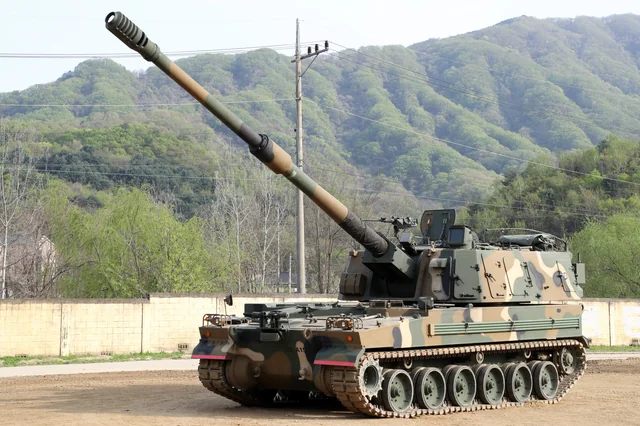
The K9 Thunder is a domestic South Korean SPG. Development started in 1989, in an effort to replace the aging M107 and K55 (M109), and partly to counter the North Korean Chuch’ep’o. The first three prototypes were built in 1996, and it entered service and full-scale production in 1999. The K9 features a domestic CN98 155mm cannon and a semiautomatic loader. Over 1,000 have been built and entered service with South Korea, including the upgraded K9A1 variant. Unlike the VIDAR in-game, the K9 does not have a laser rangefinder or thermals.
BR 7.3.
Armament: 155mm CN98
Mobility: 1000hp, 67km/h
Armour: 40/35/35mm hull; 35/35/35mm turret
☯︎ K9A2
K9A2 Thunder

The K9A2 Thunder is an upgrade for the K9/K9A1 currently in development. The first (and currently only) prototype was displayed in 2022. It features an autoloader, an extended turret, only 3 crew (as opposed to 5), and other more minor improvements. The autoloader permits a maximum rate of fire of 10 rpm, while the K9/K9A1 can manage a maximum of 6–8 rpm. The K9A2 is scheduled to enter service in 2027.
BR 7.7. Foldered with K9.
Armament: 155mm CN98
Mobility: 1000hp, 67km/h
Armour: 40/35/35mm hull; 35/35/35mm turret
✪ Chuch'e 107 155mm SPH
Chuch’e 107-model 155mm self-propelled howitzer
Suggestion Post

The Chuch’e 107-model 155mm SPH, referred to in Western sources as the ‘M2018’, is a modern, domestic North Korean SPG. It was first unveiled in 2018 (Chuch’e 107), and features a (likely L/52) 155mm howitzer in a turret on a reversed Ch’ŏnma-216 chassis. It takes design inspiration from the Iranian Raad-2, as well as the South Korean K9, and to a lesser extent the Russian 2S19M1. It has been seen frequently since, during parades and exercises. In 2020, a slightly altered version was showcased, featuring a radar-based ballistic sensor. It also carries dual 30mm AGS-30 grenade launchers. It carried a dual Igla MANPADS mount in the 2018 parade, but has not been seen fitted since.
BR 7.7
Armament: 155mm (domestic) + 2x 30mm AGS-30 + 2x Igla MANPADS launchers (2018 parade variant only)
Mobility: 780hp, 50–60km/h
Armour: Unknown. Likely 20–40mm all around.
Line 5 – SPAA
☯︎ M113 (M167)
M113 (M167)

The M113 (M167) is a South Korean prototype SPAA. Very little about the vehicle is known — it mounts the 20mm M61 Vulcan in a turret that appears to have additional armour plates surrounding it. It is mounted on an M113 hull, albeit with some additional side armour. Most importantly, it lacks the radar, allowing it to go at a slightly lower BR.
BR 7.0.
Armament: 20mm M168
Mobility: 212hp, 64km/h
Armour: 38/44/38mm hull; Unknown turret.
☯︎ K263A1
K263A1
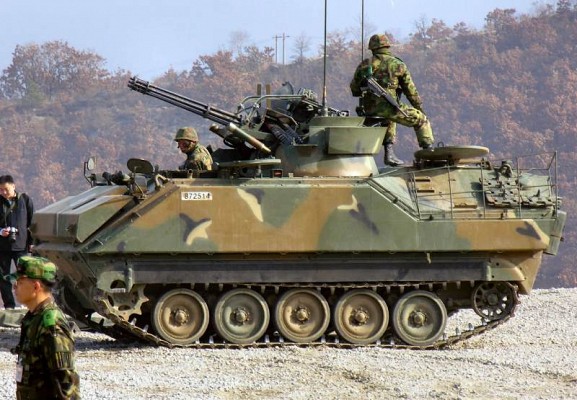
The K263A1 is an SPAA variant of the domestic South Korean K200 APC. The first vehicles were delivered in October 1987. It carries an M61 Vulcan 20mm rotary cannon in the same turret as the American M163, on the K200A1 chassis. Around 200 were produced, and they remain in service. All of them had been upgraded by 2008 with an improved FCS.
BR 7.3.
Armament: 20mm M168
Mobility: 280hp, 70km/h
Armour: Hull resists 12.7mm frontally and across sides; 17/17/17mm turret
Rank VI
Line 1 – Light Tanks, FSVs, and IFVs
☯︎ K200 (25mm)
K200 (25mm)
Suggestion Post

The K200 is a domestic South Korean APC, taking heavy inspiration from the American AIFV. The K200 was initially intended to mount a 25mm autocannon in a turret, but this idea was mostly scrapped prior to serial production in 1984. In 1987, a sole prototype of a K200 with a 25mm turret was built, and tested from 1988–89. It had a stabilised 25mm Oerlikon KBA in a one-man turret. Unlike what is commonly said online this vehicle was not part of the later KAFV program.
BR 8.3.
Armament: 25mm Oerlikon KBA
Mobility: 280hp, 70km/h
Armour: Hull resists 12.7mm frontally and across sides. Turret unknown.
✪ 8x8 FSV (122mm)
M2020 8x8 fire support vehicle (122mm)
Suggestion Post

The ‘M2020’ is a domestic North Korean 8x8 fire support vehicle unveiled in 2020. It features an unmanned turret housing a 122mm D-30 howitzer (with a presumed autoloader) on an uparmoured ‘M2010’ 8x8 APC hull. This vehicle is commonly referred to as a copy of the American Stryker, but as it carries a howitzer, is likely just intended as a replacement for the antiquated 323-based 122mm SPGs, and not a tank destroyer. It is likely that this vehicle remained in the prototype stages. It has not been seen since, and in 2025, a more refined version was revealed, indicating that the ‘M2020’ would not enter full-scale production.
BR 8.3.
Armament: 122mm D-30
Mobility: 260hp, 90km/h
Armour: Unknown, >12mm.
✪ 8x8 FSV (122mm) (2025)
M2025 8x8 fire support vehicle (122mm)
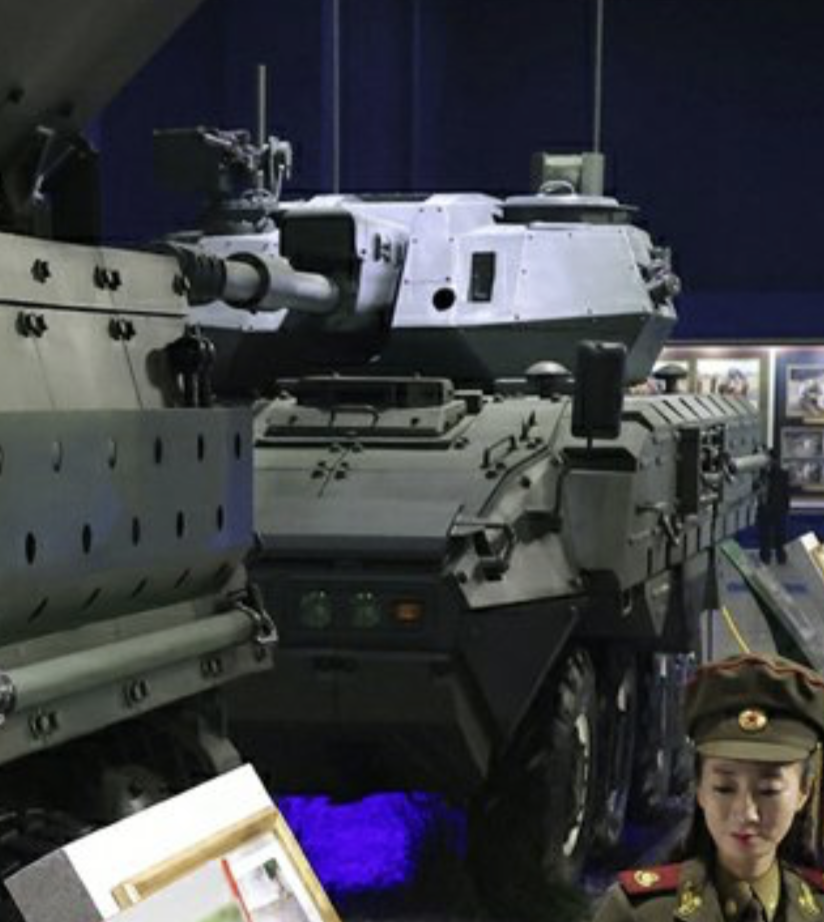
The ‘M2025’ is a domestic North Korean 8x8 fire support vehicle unveiled in 2025, and a much more refined version of the ‘M2020’. Unlike the ‘M2020’ which featured an unmanned turret, the ‘M2025’ features a turret much closer to Western designs like the Italian Hitfact Mk. II on the B2 Centauro. It retains the 122mm D-30, however. The hull has also been heavily upgraded since 2020, featuring even thicker armour, and looking significantly more modern. This vehicle is likely a candidate for serial production, although its development stage is currently unknown.
BR 8.7.
Armament: 122mm D-30
Mobility: 260hp, 90km/h (presumed)
Armour: Unknown. Likely able to resist heavy machine gun fire across front and sides.
Line 2 – South Korean Medium Tanks and MBTs
☯︎ M48A5K1
M48A5K1 Patton

Beginning in the mid-1960s, South Korea began to receive large numbers of M48 Pattons — namely the M48A1 and M48A2C. Close to 1,100 were acquired. In the late 1970s, development of two separate upgrades began. The first upgrades to the M48A1 (and some M48A2Cs) brought them to M48A3-standard — these were called M48A3K. The second set of upgrades to the remaining M48A1s brought them to M48A5-standard, and were called the M48A5K. The M48A5K1 is a variant featuring the original M48A1 turret with the M1 cupola, along with a 105mm main gun (unstabilised), a laser rangefinder, smoke grenade launchers, and sideskirts. The M48A5Ks remain in service to this day.
BR 8.3.
Armament: 105mm KM68A1
Mobility: 750hp, 48km/h
Armour: 110/76/25mm hull; 130/76/51mm turret
☯︎ M48A5K2
M48A5K2 Patton
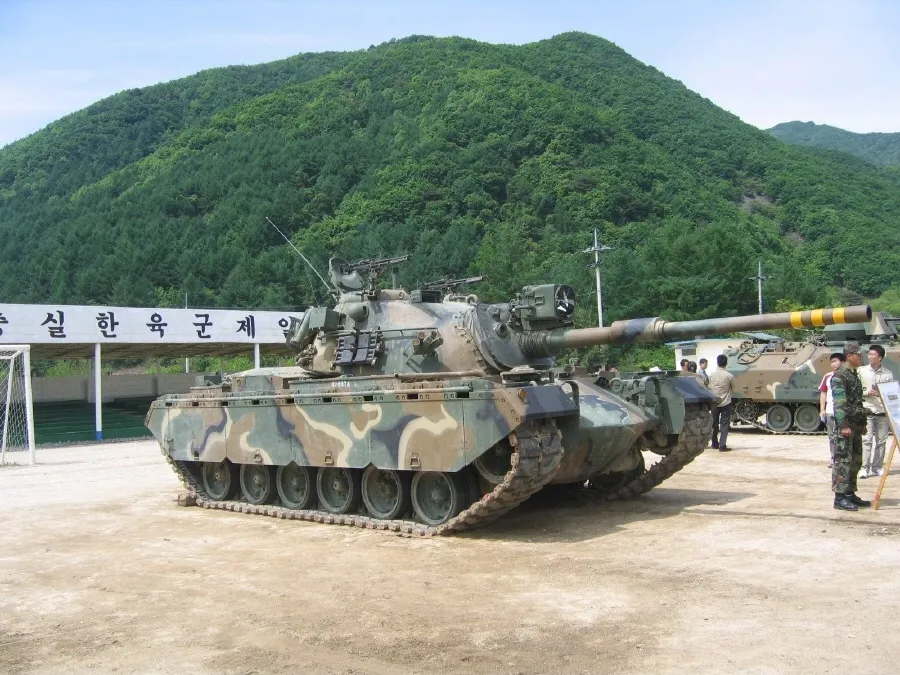
Beginning in the mid-1960s, South Korea began to receive large numbers of M48 Pattons — namely the M48A1 and M48A2C. Close to 1,100 were acquired. In the late 1970s, development of two separate upgrades began. The first upgrades to the M48A1 (and some M48A2Cs) brought them to M48A3-standard — these were called M48A3K. The second set of upgrades to the remaining M48A1s brought them to M48A5-standard, and were called the M48A5K. The M48A5K2 is a variant featuring an Israeli Urdan cupola, along with a 105mm main gun (unstabilised), a laser rangefinder, smoke grenade launchers, and sideskirts. The M48A5Ks remain in service to this day.
BR 8.3. Foldered with M48A5K1
Armament: 105mm KM68A1
Mobility: 750hp, 48km/h
Armour: 110/76/25mm hull; 130/76/51mm turret
☯︎ M48A5KW
M48A5KW
Beginning in the mid-1960s, South Korea began to receive large numbers of M48 Pattons — namely the M48A1 and M48A2C. Close to 1,100 were acquired. In the late 1970s, development of two separate upgrades began. The first upgrades to the M48A1 (and some M48A2Cs) brought them to M48A3-standard — these were called M48A3K. The second set of upgrades to the remaining M48A1s brought them to M48A5-standard, and were called the M48A5K1 and M48A5K2. The M48A5KW was a separate upgrade. These were M48A5s purchased from the US Army’s Wartime Stockpile (WRSA), and upgraded separately. They were upgraded to be near identical to the M48A5K2, but lack the sideskirts and have different smoke grenade launchers. The M48A5Ks remain in service to this day.
For the purposes of game progression, the M48A5KW should be given better APFSDS rounds to justify a higher BR.
BR 8.7.
Armament: 105mm KM68A1
Mobility: 750hp, 48km/h
Armour: 110/76/25mm hull; 130/76/51mm turret
Line 3 – North Korean Medium Tanks and MBTs
✪ Ch’ŏnma
1976-model heavy tank Ch’ŏnma
Suggestion Post

The Ch’ŏnma — known officially as the 1976-model heavy tank Ch’ŏnma — is North Korea’s domestically-produced T-62. Some confusion exists about the exact origin of the Ch’ŏnma (license-production or reverse-engineering, or a mix of both). Regardless, the first Ch’ŏnmas rolled off the factory floor in 1976 — according to North Korea — with production ramping up in 1978 and into the 1980s. The Ch’ŏnma features the hull of the T-62 obr. 1962, and the turret of the T-62 obr. 1972, as well as a domestic modification for the mounting of a 14.5mm KPV. An unknown number of Ch’ŏnmas have been produced in total, although estimates usually give a minimum of 1,000. Most initial production Ch’ŏnmas have been upgraded with provisions for slat armour.
BR 8.7.
Armament: 115mm U-5TS
Mobility: 580hp, 50km/h
Armour: 100/80/45mm hull; 200/160/65mm turret
✪ Ch’ŏnma-92
1992-model heavy tank Ch’ŏnma-92
Suggestion Post

The Ch’ŏnma is North Korea’s domestically-produced T-62. While the initial model was largely identical to the T-62, North Korea engaged in a number of upgrades. The first major upgrade was the Ch’ŏnma-92 — officially designated 1992-model heavy tank Ch’ŏnma-92 [and designated Ch’onma-ho III in Western sources] —, first revealed in 1992. This vehicle featured a new welded turret, a laser rangefinder, smoke grenade launchers, sideskirts, and ERA across the turret sides. The ERA is likely similar in characteristics to Kontakt-1. A second variant was displayed, beginning in 2012, at the KPA Exhibition of Arms and Equipment. This confirmed the name Ch’ŏnma-92, which may not actually be used for the variant shown in the parade (although I find it highly likely). This variant has fewer smoke grenade launchers, but much better ERA coverage, extending further along the turret front and sides, and being applied to the sideskirts. This variant could be a researchable modification.
BR 9.0.
Armament: 115mm U-5TS
Mobility: 580hp, 50km/h
Armour: 100/80/45mm hull + (optional) ERA across hull sides; unknown turret thickness + ERA across turret front (optional) and sides
✪ Ch’ŏnma-98
Chuch’e 89 [or 87]-model heavy tank Ch’ŏnma-98
Suggestion Post

The Ch’ŏnma is North Korea’s domestically-produced T-62. While the initial model was largely identical to the T-62, North Korea engaged in a number of upgrades. The second major upgrade was the Ch’ŏnma-98 — officially designated Chuch’e 89-model heavy tank Ch’ŏnma-98 [and designated Ch’onma-ho IV in Western sources]. It has been seen very rarely publicly, with the only confirmed public sighting being in 2012, with the opening of the KPA Exhibition of Arms and Equipment. The name suggests the vehicle entered production in 2000 (Chuch’e 89), but it was likely in development in the mid-1990s. It features a further updated welded turret, potentially with composite armour, although lacks the ERA present on the Ch’ŏnma-92.
BR 9.0. Foldered with Ch’ŏnma-92.
Armament: 115mm U-5TS
Mobility: 580hp, 50km/h
Armour: 100/80/45mm hull; unknown turret.
✪ Ch’ŏnma-214
Chuch’e 90-model heavy tank Ch’ŏnma-214
Suggestion Post

The Ch’ŏnma is North Korea’s domestically-produced T-62. While the initial model was largely identical to the T-62, North Korea engaged in a number of upgrades. The third major upgrade was the Ch’ŏnma-214 — officially designated Chuch’e 90-model heavy tank Ch’ŏnma-214 [and designated Ch’onma-ho V in Western sources]. The Ch’ŏnma-214 appears to be the production variant of the Ch’ŏnma-98, with upgrades limited to BDD-style composite armour and rubber flaps across the front of the turret, and appliqué armour on the UFP. It has been seen much more frequently than the -98, and is the last model of the Ch’ŏnma to bear a sizeable resemblance to the original T-62.
BR 9.0. Foldered with Ch’ŏnma-98 and Ch’ŏnma-92.
Armament: 115mm U-5TS
Mobility: 580hp, 50km/h
Armour: 100/80/45mm hull + appliqué of unknown effectiveness on UFP; unknown turret + BDD-style composite + rubber flaps.
✪ Ch’ŏnma-216
Chuch’e 93-model heavy tank Ch’ŏnma-216
Suggestion Post
The Ch’ŏnma-216, officially the Chuch’e 93-model heavy tank Ch’ŏnma-216, is North Korea’s most advanced Ch’ŏnma variant. Although its name suggests it was first produced in 2004 (Chuch’e 93), it likely was in development from the mid-1990s. US intelligence received reports of a new MBT being tested in 2002, leading to its designation ‘M2002’ (and later the entirely fictional ‘Pokpung-ho’) in Western sources. The Ch’ŏnma-216 features an additional roadwheel, a turret similar to the -214 but likely enhanced armour-wise (some have estimated levels close to the T-72), a new engine from the T-72, and a variety of other upgrades. It is also likely that the frontal hull armour has been upgraded, possibly with composite inspired by the T-72 (specifically the T-72 ‘Ural’). The Ch’ŏnma-216 has been widely produced and frequently seen during exercises.
BR 9.3.
Armament: 115mm U-5TS
Mobility: 780hp, 50–60km/h
Armour: Unknown. UFP may have composite armour, + appliqué of unknown effectiveness; unknown turret + BDD-style composite + rubber flaps.
✪ Ch’ŏnma-216 (2017)
Chuch’e 93-model heavy tank Ch’ŏnma-216
Suggestion Post — 2013 variant
Suggestion Post — 2017 variant
The Ch’ŏnma-216, officially the Chuch’e 93-model heavy tank Ch’ŏnma-216, is North Korea’s most advanced Ch’ŏnma variant. In 2013, an upgrade package was seen. This featured a rear-mounted HT-16PGJ (Igla) missile, as well as more importantly, a dual Bulsae-2 (or -4) ATGM launcher. These ATGMs are locally-produced 9M111-2 Fagots, able to penetrate 460mm of RHA. The exact model present on the 2013 weapons package is unclear — they are likely, however, to be base Bulsae-2s. The vehicle also features a dual 30mm AGS-17 grenade launcher in place of the 14.5mm KPV. In 2017, a second, more refined upgrade package was seen. It features ERA across the hull front, possibly similar to Chinese FY-I or FY-II, a dual MANPADS launcher that appears to be integrated properly with the FCS, an upgraded laser rangefinder, a LWR system, and an updated ATGM launcher. The laser rangefinder appears to be able to guide the ATGMs, thus meaning the ATGMs on this model are likely to be the updated laser-beam riding Bulsae-4 or Bulsae-4M (differing only in range). This likely means they could be fired on the move — however, they likely retain the same penetration of 460mm.
In-game, the 2013 variant should be the base variant, with the 2017 being an upgrade package changing the model, like on the T-72B3 and its UBH modification.
BR 9.7. Foldered with Ch’ŏnma-216.
Armament: 115mm U-5TS + 1–2x HT-16PGJ MANPADS launchers + 2x Bulsae-2 or Bulsae-4/4M ATGM launchers
Mobility: 780hp, 50–60km/h
Armour: Unknown. UFP may have composite armour, + appliqué of unknown effectiveness + ERA (2017 model only); unknown turret + BDD-style composite + rubber flaps.
Line 4 – Tank Destroyers and ATGM Carriers
☯︎ K200 (TOW)
K200 (TOW)

The K200 is a domestic South Korean APC, taking heavy inspiration from the American AIFV. It entered production in 1984, and a number of different variants have been produced, including SPAA and prototype IFVs. In 1983, before the K200 entered service, a prototype of an ATGM carrier was produced. This vehicle featured a very similar design to the American M113 (TOW), with a single TOW ATGM launcher mounted on an opened hull. This vehicle was built by December 1983. Despite apparent successes, the vehicle was cancelled and remained a prototype.
BR 8.3.
Armament: 1x TOW ATGM launcher
Mobility: 280hp, 70km/h
Armour: Hull resists 12.7mm frontally and across sides
☯︎ K200 (Metis-M)
K200 (Metis-M)

The K200 is a domestic South Korean APC, taking heavy inspiration from the American AIFV. It entered production in 1984, and a number of different variants have been produced, including SPAA and prototype IFVs. In 1995, South Korea and Russia signed an agreement for the delivery of a number of Russian weapon systems and vehicles in order to pay off Russian debt. This included 70 9K115-2 Metis-M ATGM launchers, and 1,250 missiles. A second delivery of 156 launchers and 11,500 missiles took place from 2002–2006. These missiles have tandem warheads capable of penetrating 800mm of armour behind ERA. An unknown number of K200s have been modified to carry a Metis-M launcher, which remain in service. Some sources indicate they will be replaced with the domestic AT-1K Raybolt ATGM.
BR 9.0.
Armament: 1x METIS-M ATGM launcher
Mobility: 280hp, 70km/h
Armour: Hull resists 12.7mm frontally and across sides
✪ 8x8 FSV (Bulsae-5)
M2020 8x8 fire support vehicle (Bulsae-5)
Suggestion Post

The ‘M2020’ (official designation unknown) is a domestic North Korean 8x8 ATGM carrier revealed in 2020. It carries a turret with 5x Bulsae-5 ATGM launchers: the Bulsae-5 is North Korea’s designation for their domestically-produced 9M133 Kornet. These ATGMs are laser-beam riding, have a tandem warhead, and penetrate 1200mm of RHA. The turret is fitted to a modified ‘M2010’ 8x8 chassis (itself a copy of the BTR-80, with some features from the BTR-60PB and PT-76B) fitted with appliqué armour across the whole vehicle. It hasn’t been seen much outside of the 2020 parade, aside from a few short clips showing it firing its missiles.
BR 9.7.
Armament: 5x Bulsae-5 ATGM launchers
Mobility: 260hp, 90km/h
Armour: Unknown, >12mm.
Line 5 – SPAA
✪ 30mm SPAAG
30mm twin-barrelled automatic anti-aircraft gun
Suggestion Post
The 30mm twin-barrelled automatic anti-aircraft gun, known in Western circles as the ‘M1989’ or ‘M1992’, is a North Korean SPAA developed in the early-1980s. It features a domestically-produced (and slightly modified) GMZ-575 chassis, the same type as the ZSU-23-4. North Korea received a few of these vehicles in the early 1970s, which likely kickstarted the development of this SPAA. The first prototype of this vehicle was spotted in 1983. It features a turret similar in shape to the ZSU-23-4, but with two 30mm AK-230 autocannons slaved to an MR-104 ‘Drum Tilt’ radar, providing slightly better firepower (albeit lower combined rate of fire) and target acquisition.
BR 8.3.
Armament: 2x 30mm AK-230
Mobility: 280hp, 50km/h
Armour: 9/9/7mm hull; Unknown turret (~8mm)
☯︎ K30W Cheonho
K30W 30mm wheeled anti-aircraft gun (Cheonho)
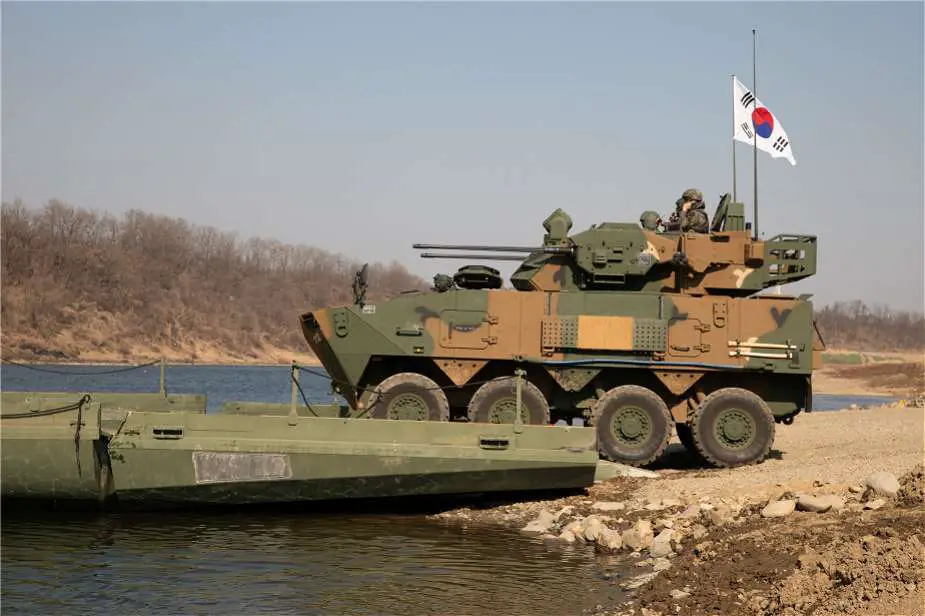
The K30W Cheonho is an 8x8 wheeled SPAA developed on the hull of the K808 APC, that entered service in 2021. The turret is based on the K30 Biho, but lacks the radar and missiles (of the upgraded K30 variant). It, nonetheless, has an advanced FCS with thermals and a laser rangefinder. It carries two 30mm auto cannons in a similar arrangement to systems like the Gepard, Marksman, and ZA-35.
BR 8.3 Foldered with 30mm SPAAG.
Armament: 2x 30mm KKCB
Mobility: 420hp, 100km/h
Armour: Thin, frontal hull arc resists 12.7mm. Turret ~10–25mm
☯︎ K30 Biho
K30 Biho
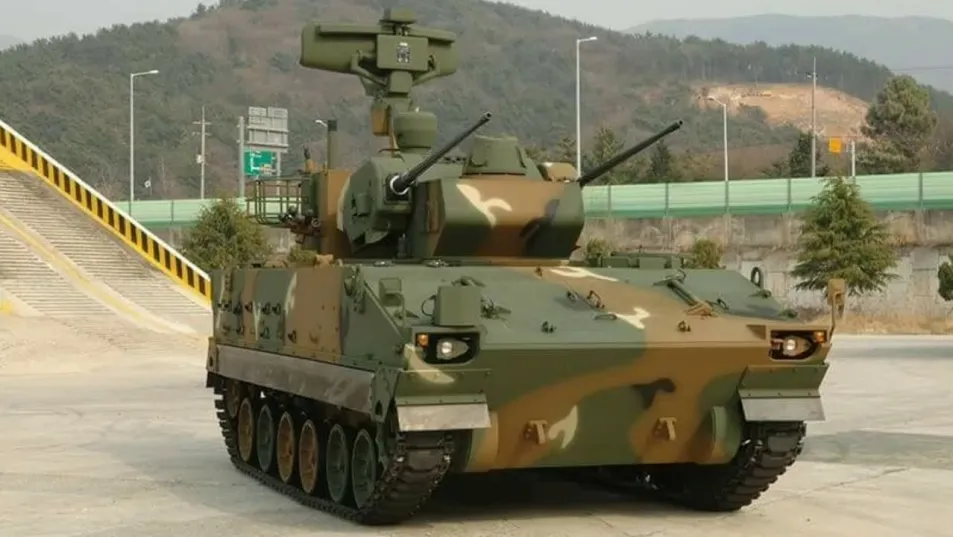
The K30 Biho is a tracked SPAA developed on a modified / extended K200 chassis. Development began in 1983, and the first prototypes were built in 2001. Production began in 2008, and 176 vehicles have been built. The vehicle features a turret housing dual 30mm auto cannons, an advanced FCS and electro-optical system, and a search radar.
BR 8.7.
Armament: 2x 30mm KKCB
Mobility: 520hp, 65km/h
Armour: Thin, frontal hull arc resists 12.7mm. Turret ~10–25mm
✪ 323 (9K38)
323 (9K38)
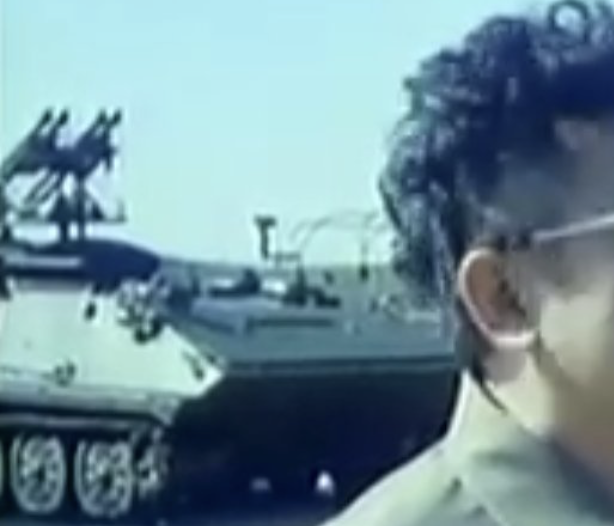
The 323 — officially the 1973-model armoured personnel carrier 323 — is a domestic North Korean APC, produced since 1973, derived from the Chinese Type 63 / YW531A. It has been produced in huge numbers, and although in its most basic form features a turret with dual 14.5mm KPV HMGs, has been used as the basis for a number of different vehicles, including SPAA and SPGs. One such example of this is the 323 (9K38). This vehicle has been rarely sighted, but features four MANPADS on a rotating platform. The vehicle has no radar or FCS. The exact model of missile is unclear, but is likely to either be the Strela-3 or Igla-1 — presumably the latter.
BR 9.0.
Armament: 4x Igla-1 MANPADS launchers
Mobility: 320hp, 60km/h
Armour: 12/8/8mm hull
Rank VII
Line 1 – Light Tanks, FSVs, and IFVs
☯︎ K21-105 (CT-CV)
K21-105 (CT-CV 105HP)
Suggestion Post
The K21 (CT-CV) is a light tank — technically classified as a medium tank — revealed in 2014 by Doosan and the Belgian company John Cockerill (CMI Defence). It features a Cockerill CT-CV 105HP turret on a modified K21 IFV’s hull — this turret has a 105mm cannon, an autoloader, and an advanced FCS. The vehicle has undergone trials, but has not been purchased by any customer.
BR 10.0.
Armament: 105mm L/50
Mobility: 750hp, 70km/h
Armour: Frontal hull resist 30mm APDS; sides and rear resist 14.5mm rounds; 20/20/20mm turret
☯︎ K21-105 (XC-8)
K21-105 (XC-8-105)
The K21 (XC-8-105) is a light tank — technically classified as a medium tank — revealed in 2013 by Doosan and the Belgian company John Cockerill (CMI Defence), alongside an alternative version with a 120mm cannon. It features a Cockerill XC-8-105 turret on a modified K21 IFV’s hull — this turret has a 105mm cannon, an autoloader, and an advanced FCS. The vehicle has not been purchased by any customer, and is likely to have been discarded in favour of the K21 with the CT-CV 105HP turret.
BR 10.3. Foldered with K21 (CT-CV 105HP).
Armament: 105mm L/50
Mobility: 750hp, 70km/h
Armour: Frontal hull resist 30mm APDS; sides and rear resist 14.5mm rounds; 20/20/20mm turret
☯︎ K21
K21
Suggestion Post
The K21 is South Korea’s domestic tracked IFV, based on the K200 APC chassis. The vehicle began development in 1999, and three prototypes were delivered in 2005. Production began in 2009, with 466 vehicles produced. The K21 features a turret housing a 40mm autocannon, and a FCS with a laser rangefinder and third-generation thermal sights. The vehicle has served as the basis for a number of other light tanks and IFVs.
BR 10.3.
Armament: 40mm K40
Mobility: 750hp, 70km/h
Armour: Frontal hull resist 30mm APDS; sides and rear resist 14.5mm rounds.
☯︎ K21 AT-1K
K21 AT-1K
Suggestion Post
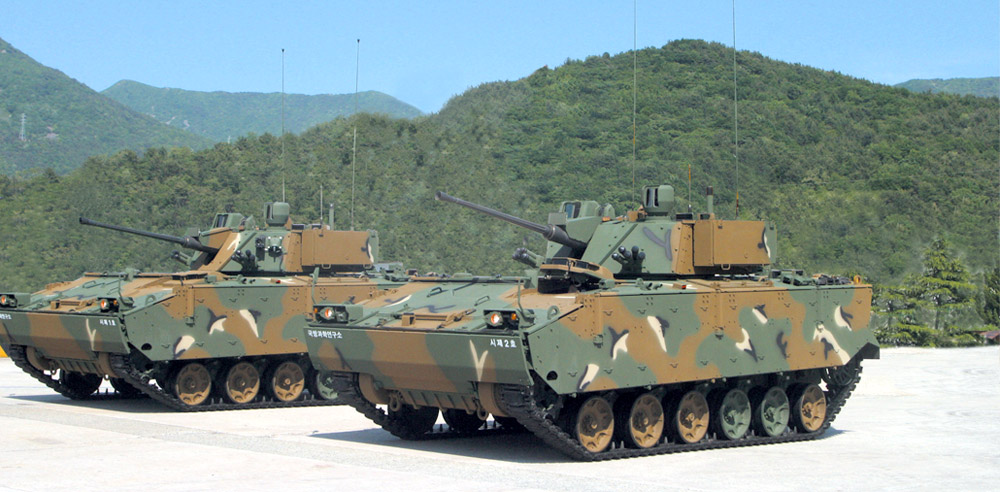
The K21 is South Korea’s domestic tracked IFV, based on the K200 APC chassis. The vehicle began development in 1999, and three prototypes were delivered in 2005. Production began in 2009, with 466 vehicles produced. The K21 features a turret housing a 40mm autocannon, and a FCS with a laser rangefinder and third-generation thermal sights. The vehicle has served as the basis for a number of other light tanks and IFVs. Since development of the K21 began, ATGM launchers have been planned — some vehicles have been seen with mock-up launchers on the sides of the turret. The ATGM in question is the AT-1K Raybolt / Hyeongung, which only entered production in 2017 (hence all vehicles seen with launchers before were definitely mock-ups). The K21 PIP is a widely-claimed upgrade program for the K21, which intends to fit it with a hard-kill APS, ATGM launchers, and improved armour, but this may not actually enter full-scale development or production.
This vehicle is technically not real, but given that all the components have been built, and mock-up launchers installed on the K21, it could reasonably be added.
BR 10.7. Foldered with K21.
Armament: 40mm K40 + 2x AT-1K ATGM launchers
Mobility: 750hp, 70km/h
Armour: Frontal hull resist 30mm APDS; sides and rear resist 14.5mm rounds.
☯︎ K-NIFV
K-NIFV
The K-NIFV is a modern IFV unveiled in 2025, developed by Hanwha Defense on the basis of their AS21 Redback design. The vehicle features a new unmanned turret housing a 30mm Bushmaster autocannon (with potential for a 40mm CTA), two TAipers-L (Cheongeom) ATGM launchers, an anti-drone system, and a hard-kill APS. The vehicle is being offered to the South Korean Army to replace the K200 APC, with a second version (Block 2, with a new powertrain and suspension) to replace the K21.
BR 11.0.
Armament: 30mm Bushmaster II Mk. 44S + 2x TAipers-L ATGM launchers
Mobility: 1000hp, 70km/h
Armour: Up to STANAG Level 6
Line 2 – South Korean Medium Tanks and MBTs
☯︎ XK1
XK1
Suggestion Post
The XK1 is the pre-production variant of the K1, South Korea’s first domestic MBT. In the 1970s, South Korea began looking for a domestic MBT on par with the Leopard 2 and M1 Abrams. Chrysler responded with their proposal, based on the XM1. Development began under the name ROKIT, and the first prototype (automative test rig) was built in 1983, followed shortly after by the fire control test rig. Five fully functional prototypes were built afterwards, designated XK1, before production began in 1987. 1,511 tanks were produced, and production ended in 2011.
BR 10.3.
Armament: 105mm KM68A1
Mobility: 1200hp, 65km/h
Armour: Classified composite array, using Chobham. ~400–500mm effective protection against KE frontally.
☯︎ K1 (Early)
K1 (Early)
Suggestion Post

The K1 is South Korea’s first domestic MBT. In the 1970s, South Korea began looking for a domestic MBT on par with the Leopard 2 and M1 Abrams. Chrysler responded with their proposal, based on the XM1. Development began under the name ROKIT, and the first prototype (automative test rig) was built in 1983. Production began in 1987 — 1,511 tanks were built until production ended in 2011. The initial production batch of 477 (or 445) vehicles were fitted with the Hughes Gunner’s Primary Sight System (GPSS), which was replaced with the GPTTS on all K1s afterwards. This wouldn’t change the vehicle much, if at all, in-game, but does allow for a premium variant at the same BR.
BR 10.7.
Armament: 105mm KM68A1
Mobility: 1200hp, 65km/h
Armour: Classified composite array, using Chobham. ~400–500mm effective protection against KE frontally.
☯︎ K1E1
K1E1
Suggestion Post
The K1E1 is an upgrade to the K1 that first began in 2013. Production of the base K1 had ended just two years prior, in 2011. The K1E1 program focused on upgrading the K1 in a similar vein to how the K1A1 was upgraded to the K1A2, by applying technology from the K2 Black Panther. This included an upgraded commander’s sight and access to better ammunition (for in-game balance reasons). The first K1E1 was upgraded in 2014, and the upgrades are planned to be complete by 2026.
BR 11.0.
Armament: 105mm KM68A1
Mobility: 1200hp, 65km/h
Armour: Classified composite array, using Chobham. ~400–500mm effective protection against KE frontally.
☯︎ K1E2
K1E2
Suggestion Post
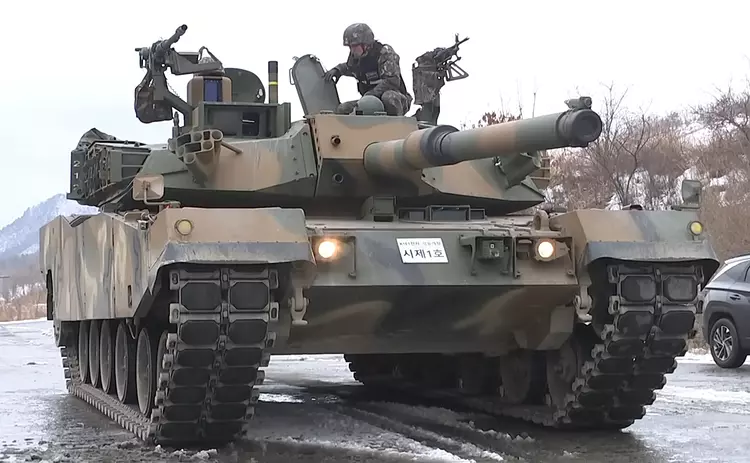
The K1E2 is an ongoing upgrade of the K1E1. Initially it was much more comprehensive (incl. improved base armour, an urban warfare armour kit, an APS and a RWS, and a new engine), but was reduced to 3 key upgrades: an improved gunner’s sight (replacing the first-generation thermal sight), an APU, and an overpressure system for CBRN protection. The first K1E2 prototype was revealed in 2024, and the upgrade program is slated to commence in 2026. For in-game reasons, this should have access to better ammunition, possibly including the 105mm NG APFSDS.
BR 11.3 Foldered with K1E1.
Armament: 105mm KM68A1
Mobility: 1200hp, 65km/h
Armour: Classified composite array, using Chobham. ~400–500mm effective protection against KE frontally.
☯︎ K1A1
K1A2
The K1A1 is an upgrade to the K1, very similar in scope to the American M1A1. South Korea indicated their interest in an upgrade in 1985, and official development began in 1991. The tank would feature a domestically-produced 120mm smoothbore, along with domestic ammunition. The first prototype was revealed in 1996, and production began in 1999. Aside from the 120mm, the K1A1 also features improved armour, utilising KSAP instead of SAP. 484 vehicles were built until production ended in 2011.
BR 11.3.
Armament: 120mm KM256
Mobility: 1200hp, 65km/h
Armour: Classified composite array, using an improved armour based on Chobham. ~600mm effective protection against KE frontally.
☯︎ K1A2
K1A2
The K1A2 is an upgrade to the K1A1. Development began in 2008, focusing on the installation of a battlefield management system, IFF, and a thermal sight for the driver. The first K1A2 was revealed in 2012, and the upgrade officially started in 2013. In 2024, the upgrade program was complete, although the exact number of vehicles modernised is unknown.
BR 11.3. Foldered with K1A1.
Armament: 120mm KM256
Mobility: 1200hp, 65km/h
Armour: Classified composite array, using an improved armour based on Chobham. ~600mm effective protection against KE frontally.
Line 3 – North Korean Medium Tanks and MBTs
✪ Sŏn’gun-915
Chuch’e 98-model heavy tank Sŏn’gun-915
Suggestion Post

The Sŏn’gun-915 — officially the Chuch’e 98-model heavy tank Sŏn’gun-915 — is a domestic North Korean MBT first revealed in 2010. It is radically different to the older Ch’ŏnma-series, with much more inspiration taken from the T-72. It features a new larger cast turret equipped with a 125mm cannon (likely derived from the Soviet 2A26), instead of the 115mm on the Ch’ŏnma-series. It uses a hull similar to the Ch’ŏnma-216, but with some alterations, including adopting crew positions of the T-72 (driver in the centre). Despite being derived partially from the T-72, the Sŏn’gun-915 lacks an autoloader. According to North Korea, it weighs 44t, has a 1200hp engine, and has a top speed of 70km/h. The turret supposedly has an effective thickness of 900mm, although this is probably somewhat exaggerated.
BR 10.0.
Armament: 125mm 2A26 (mod.)
Mobility: 1200hp, 70km/h
Armour: Unknown. Hull likely has composite, similar to (or better than) the T-72 Ural. Turret claimed to be ~900mm effective (presumably against CE rounds)
✪ Sŏn’gun-915 (2012/2018)
Chuch’e 98-model heavy tank Sŏn’gun-915
Suggestion Post — 2012 variant
Suggestion Post — 2018 variant
The Sŏn’gun-915 — officially the Chuch’e 98-model heavy tank Sŏn’gun-915 — is a domestic North Korean MBT first revealed in 2010. It is radically different to the older Ch’ŏnma-series, with much more inspiration taken from the T-72. It features a new larger cast turret equipped with a 125mm cannon, an upgraded 1200hp engine, and thick (likely composite) armour. In 2012, a new variant of the Sŏn’gun-915 was shown in a parade, featuring double-stacked ERA on the turret front, and singular ERA bricks on the turret roof and hull UFP. This variant now appears to be the standard variant, and has been seen in various training exercises. In 2018, a second variant appeared, featuring a new weapons package similar to the 2017-model Ch’ŏnma-216. It equipped the Sŏn’gun-915 with two Bulsae-5 (9M133 Kornet) ATGM launchers, replaced the 14.5mm KPV with a dual 30mm AGS-17 grenade launcher, and two MANPADS launchers in the rear (likely firing the domestic HT-16PGJ).
The 2018 upgrade package should be an optional modification in-game.
BR 10.3. Foldered with Sŏn’gun-915.
Armament: 125mm 2A26 (mod.) + 2x Bulsae-5 ATGM launchers + 2x 30mm AGS-17 + 2x MANPADS launchers
Mobility: 1200hp, 70km/h
Armour: Unknown. Hull likely has composite, similar to (or better than) the T-72 Ural + ERA across UFP. Turret claimed to be ~900mm effective (presumably against CE rounds) + ERA with ~500mm effective protection
Line 4 – Tank Destroyers and ATGM Carriers
☯︎ K153C1
K153C1
The Kia KLTV is a family of South Korean armoured cars, developed in the mid-2010s. One variant is the K153C1, an ATGM carrier on the K153C chassis (an up-armoured, reconnaissance variant). It features two AT-1K Raybolt (Hyeongung) ATGM launchers. The AT-1K is a fire-and-forget missile, equipped with a tandem warhead capable of penetrating 900mm of RHA behind ERA. The vehicle can carry four additional missiles, for a total of six.
BR 10.0.
Armament: 2x AT-1K ATGM launchers
Mobility: 222hp, 130km/h
Armour: Resists small-arms fire only.
Line 5 – SPAA
✪ Hwasŭngch'ong 10
1976-model self-propelled Hwasŭngch’ong Type 10
Suggestion Post
The 1976-model self-propelled Hwasŭngch’ong Type 10 is the official name given to the Soviet Strela-10 in North Korean service (North Korea uses the term Hwasŭngch’ong to refers to all MANPADS; the name Pŏn’gae-3 is sometimes used for this vehicle, but this appears to be inaccurate). An unknown number were delivered in the 1980s, and they remain one of North Korea’s most effective short-range air defence systems. Some vehicles have been modified to carry 8 launchers for the HT-16PGJ MANPADS, a modernised copy of the 9K310 Igla-1 with the seeker and improved flight characteristics of the 9K38 Igla (9M39 missile). These were first revealed in 2017.
BR 10.0.
Armament: 8x HT-16PGJ MANPADS launchers
Mobility: 240hp, 62km/h
Armour: 14/7/7mm hull; 7/7/7mm turret
☯︎ K30 Biho-Hybrid
K30 Biho-Hybrid

The K30 Biho is a tracked SPAA developed on a modified / extended K200 chassis. Development began in 1983, and the first prototypes were built in 2001. Production began in 2008, and 176 vehicles have been built. The vehicle features a turret housing dual 30mm auto cannons, an advanced FCS and electro-optical system, and a search radar. In 2013, an upgraded system was shown, called Biho-Hybrid. It integrated two Singung MANPADS launchers (with 2 missiles each) on either side of the turret. This vehicle entered production in 2015, and entered service in 2018.
BR 10.0. Foldered with Hwasŭngch’ong 10.
Armament: 2x 30mm KKCB + 4x Singung MANPADS
Mobility: 520hp, 65km/h
Armour: Thin, frontal hull arc resists 12.7mm. Turret ~10–25mm
✪ M2020 Short-Range SAM
M2020 Short-Range SAM
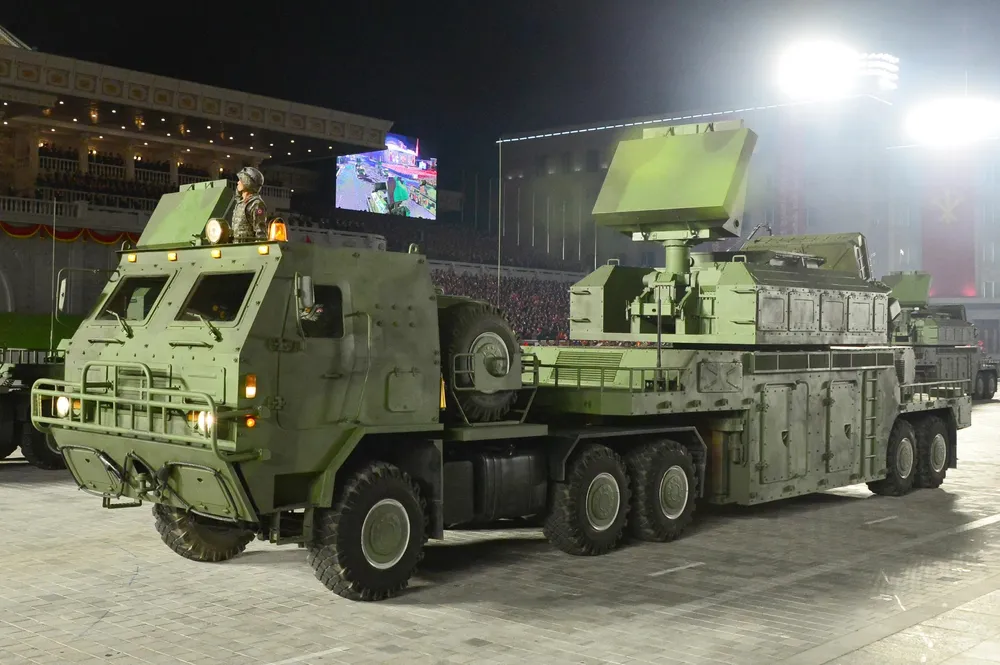
The ‘M2020’ — official designation unknown — is a domestic North Korean short-range SAM system, unveiled in 2020. The vehicle has a trailer-mounted launcher/radar system similar to the Russian Tor (or Chinese equivalent, HQ17), pulled by a truck. The vehicle has been seen in use in Russia (and a blurry photo exists of it undergoing testing), confirming its functionality.
BR 11.7.
Armament: Unknown. Likely 8x missiles, possibly HQ17 or domestic equivalent.
Mobility: Unknown.
Armour: Likely able to resist small-arms fire.
Rank VIII
Line 1 – Light Tanks, FSVs, and IFVs
☯︎ K21-120
K21-120 (XC-8-120)
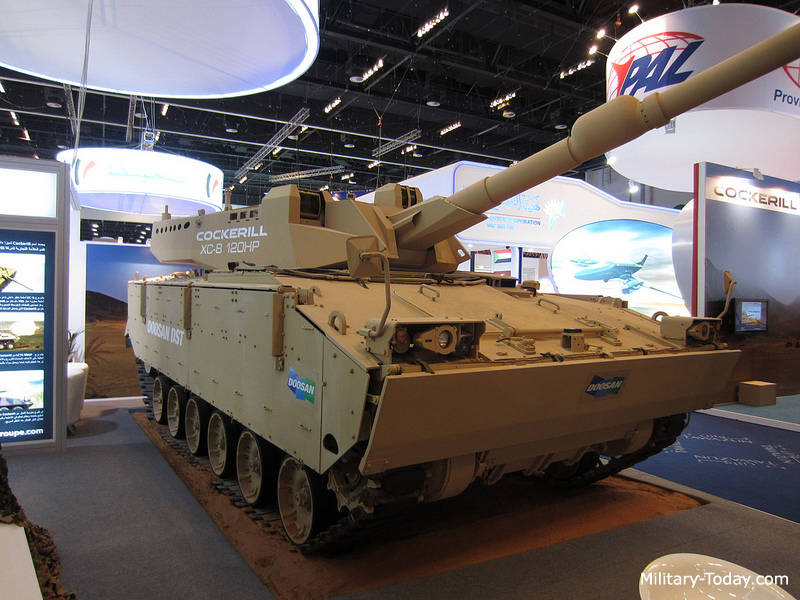
The K21-120 is a light tank — technically classified as a medium tank — revealed in 2013 by Doosan and the Belgian company John Cockerill (CMI Defence), alongside an alternative version with a 105mm cannon. It features a Cockerill XC-8-120 turret on a modified K21 IFV’s hull — this turret has a 120mm cannon, an autoloader, and an advanced FCS. The vehicle has not been purchased by any customer.
BR 12.0.
Armament: 120mm CTG (L/50)
Mobility: 750hp, 70km/h
Armour: Frontal hull resist 30mm APDS; sides and rear resist 14.5mm rounds; 20/20/20mm turret
Line 2 – South Korean Medium Tanks and MBTs
☯︎ K2
K2 Black Panther
Suggestion Post
The K2 Black Panther is South Korea’s most modern MBT. Initial development began in 1992 to design concepts. A number of different systems were developed from 1998–2002, including the cannon, autoloader and APS. Full-scale development began in 2003, and the first prototypes were built in 2007. Production began in 2011: 300 had been produced in three batches by 2024, with a fourth batch scheduled to begin that year for 150 more vehicles. The K2 is one of the most advanced production MBTs in the world. It features an automatically-loaded 120mm cannon, very strong composite armour (able to withstand 120mm APFSDS rounds frontally) and ERA, an advanced FCS and sights, hydropneumatic suspension, and excellent mobility.
BR 12.7.
Armament: 120mm CN08
Mobility: 1500hp, 70km/h
Armour: Advanced composite array, frontal armour capable of resisting 120mm K276 APFSDS (650mm @ 0°). Side armour resists 30mm AP / APDS, depending on location.
☯︎ XK2 (KAPS)
XK2 (Korean Active Protection System)
Suggestion Post
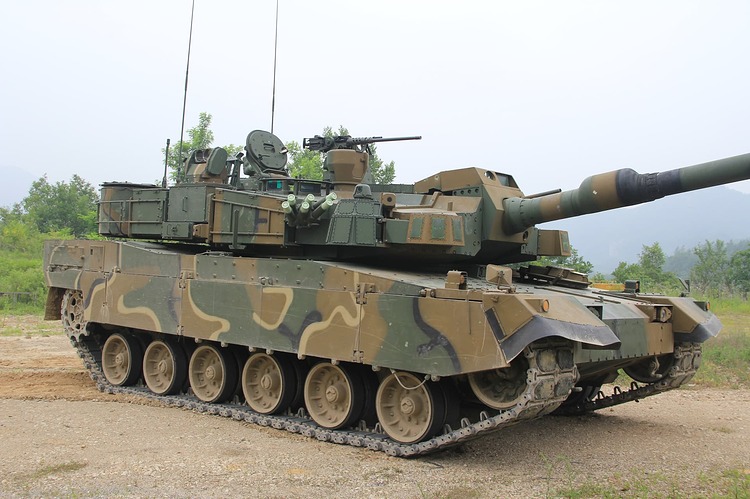
The K2 Black Panther is South Korea’s most modern MBT. Initial development began in 1992 to design concepts. A number of different systems were developed from 1998–2002, including the cannon, autoloader and APS. Full-scale development began in 2003, and the first prototypes — designated XK2 — were built in 2007. After production began in 2011, one XK2 prototype was tested with the hard-kill Korean Active Protection System (KAPS). However, due to safety concerns, it was not integrated on the production model. A new version called KAPS-2, based on the Israeli Trophy, is in development, and has been seen on the K2EX prototype.
BR 12.7. Foldered with K2.
Armament: 120mm CN08
Mobility: 1500hp, 70km/h
Armour: Advanced composite array, frontal armour capable of resisting 120mm K276 APFSDS (650mm @ 0°). Side armour resists 30mm AP / APDS, depending on location.
☯︎ K2EX
K2EX
Suggestion Post
The K2 Black Panther is South Korea’s most modern MBT. Initial development began in 1992 to design concepts. A number of different systems were developed from 1998–2002, including the cannon, autoloader and APS. Full-scale development began in 2003, and the first prototypes were built in 2007. Production began in 2011. The K2EX is an upgraded variant for the export market, first seen in 2024. It features an RCWS, a drone jamming system, and the KAPS-2 hard-kill APS (a variant of Trophy). The K2EX itself has not yet been bought by any country, but the K2PL currently under development for Poland shares a number of the same features.
BR 12.7.
Armament: 120mm CN08
Mobility: 1500hp, 70km/h
Armour: Advanced composite array, frontal armour capable of resisting 120mm K276 APFSDS (650mm @ 0°). Side armour resists 30mm AP / APDS, depending on location.
Line 3 – North Korean Medium Tanks and MBTs
✪ Ch’ŏnma-20 (P)
Chuch’e 109-model heavy tank Ch’ŏnma-20
Suggestion Post — 2020 variant
Suggestion Post — 2023 variant
The Ch’ŏnma-20, formerly believed to be called Ch’ŏnma-2, is North Korea’s most advanced MBT to date. It is radically different to the preceding Ch’ŏnma-series and Sŏn’gun-915, featuring a design much closer to typical Western designs, while retaining some clear Russian influence. The vehicle was first revealed in 2020, and was likened to the Russian T-14 Armata. In 2023, it was seen with ERA. In 2024, a wholly new variant was seen, and in 2025 the name Ch’ŏnma-20 was confirmed. The 2020/2023 model likely represents prototypes / pre-production vehicles, with the 2024 model presumably entering serial production. The 2020 model features a design reminiscent of the M1 Abrams. It carries a 125mm cannon, two Bulsae-5 (9M133 Kornet) ATGM launchers, and a hard-kill APS embedded in the turret inspired by the Russian Afghanit system and the T-14 Armata. The 2023 variant, which should be in-game as a modification, adds double-stacked ERA across the turret front, single ERA blocks across the turret sides, and improved side armour.
BR 12.0.
Armament: 125mm 2A26 (mod.) + 2x Bulsae-5 ATGM launchers
Mobility: 1500hp, 70km/h
Armour: Unknown. Composite armour of presumably decent quality, likely on par with later T-72 and T-80 variants, + ERA (2023 model).
✪ Ch’ŏnma-20
2020-model heavy tank Ch’ŏnma-20
Suggestion Post — 2024 variant
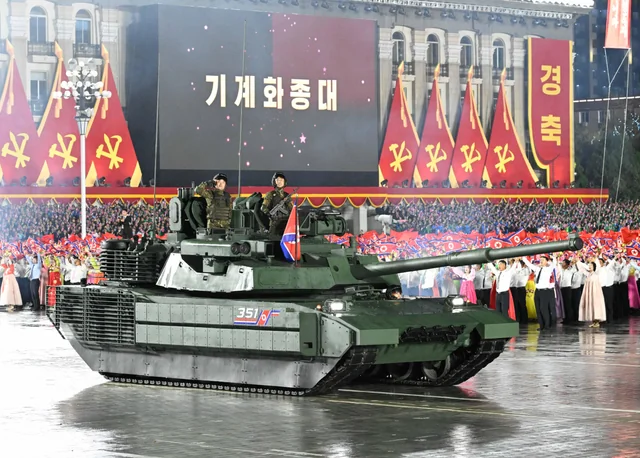
The Ch’ŏnma-20, formerly believed to be called Ch’ŏnma-2, is North Korea’s most advanced MBT to date. It is radically different to the preceding Ch’ŏnma-series and Sŏn’gun-915, featuring a design much closer to typical Western designs, while retaining some clear Russian influence. The vehicle was first revealed in 2020, and was likened to the Russian T-14 Armata. In 2023, it was seen with ERA. In 2024, a wholly new variant was seen, and in 2025 the name Ch’ŏnma-20 was confirmed. This variant appears much more refined. The turret has been completely redesigned from the M1-style turret, instead much closer to the South Korean K2. It carries a redesigned APS, this time similar to the Israeli Iron Fist, with 8 launchers in total. A slightly redesigned variant appeared in 2025, with the driver moved back to a T-62-style position, and a deep-wading kit added at the rear of the turret.
BR 12.7.
Armament: 125mm 2A26 (mod.) + 2x Bulsae-5 ATGM launchers
Mobility: 1500hp, 70km/h
Armour: Unknown. Composite armour of presumably decent quality, likely on par with later T-72 and T-80 variants, or even the K2 Black Panther. ERA across sideskirts.
Line 4 – Tank Destroyers and ATGM Carriers
✪ 4x4 ATGM Carrier
M2025 4x4 ATGM Carrier
The ‘M2025’ (official designation unknown) is a domestic North Korean 4x4 ATGM carrier revealed in 2025. It is based on an unknown model of armoured car, and features six NLOS ATGM launchers in its rear bed. This vehicle, unlike the 6x6 and 8x8 NLOS ATGM carriers (the latter of which is in this tree as well), would not be able to carry any spare missiles, and cannot fire directly in front of it (it is also possible that the launchers have limited traverse). This variant, mounted on a different vehicle, has been seen in use by North Korean forces in Russia.
BR 11.3.
Armament: 6x NLOS ATGM launchers
Mobility: Unknown.
Armour: Unknown. Likely to resist small-arms fire.
✪ 8x8 ATGM Carrier
M2024 8x8 ATGM Carrier
Suggestion Post

The ‘M2024’ (official designation unknown) is a domestic North Korean 8x8 ATGM carrier revealed in 2024. It features a turret housing eight NLOS ATGM launchers, on an unmodified ‘M2010’ 8x8 hull. The ATGMs are relatively unknown, but share many similarities with the Israeli Spike-NLOS, as well as the Chinese HJ-10. These missiles have long ranges, and are guided from the missile itself. This vehicle has only been seen once, at an exhibit in 2024, although appears to be an attempt to improve the 6x6 variant, which has been seen more frequently — the 8x8 hull presumably allows it to store more ammunition, or improve crew ergonomics.
BR 11.7.
Armament: 8x NLOS ATGM launchers
Mobility: 260hp, 90km/h
Armour: Unknown, ~9–12mm.
Line 5 – SPAA
☯︎ K31 Cheonma
K31 Cheonma
Suggestion Post
The K31 Cheonma is a South Korean SHORAD, based on the French Crotale system. It was developed in the 1990s — only around 100 vehicles have been produced. The vehicle features a turret with eight launchers for the Cheonma missile, a domestic South Korean SAM with characteristics similar to the VT1, mounted on a modified K200 chassis.
BR 12.0.
Armament: 8x Cheonma SAM launchers
Mobility: 520hp, 60km/h
Armour: Hull resists 12.7mm frontally and across sides; 8/8/8mm turret
☯︎ Cheongung
KM-SAM Cheongung (Block II)
Suggestion Post
The KM-SAM Cheongung is a South Korean multi-vehicle HIMAD system. The SAM-X program began in 1991, to replace aging US SAM systems. In 1999, a separate project — codenamed Cheolmae-II — began, to develop a domestic system, instead of importing one like the SAM-X program was looking at doing. In 2010, the official name of the domestic system was revealed: Cheongung. It entered mass-production in 2015, and service in 2016 — all deliveries were complete in 2020. The vehicle has two variants, Block I and Block II — the latter should still be able to fire Block I missiles. The Block I missile is a standard fragmentation blast warhead, with a speed of Mach 4.5, a range of 40km, and a 15–20km flight ceiling. The Block II missile uses a hit-to-kill warhead, with improved speed (Mach 5) and horizontal range (50km).
BR 12.7.
Armament: 8x Cheongung launchers (per vehicle, 2 launcher vehicles available)
Mobility: 450hp, 90km/h
Armour: 0/0/0mm hull; 0/0/0mm turret
Premium / Event Vehicles
Rank III
✪ Cromwell V
A27M Cromwell V
Suggestion Post

The Cromwell V is a British medium tank, developed in WW2. It entered service in 1944, and over 4,000 were constructed. The Cromwell V variant was armed with the 75mm ROQF Mk. V. The Cromwell saw some service in the Korean War, being used by British troops. On the 3rd January 1951, Chinese forces fought the British 29th Infantry Brigade, equipped with 14 Cromwells — all of which were destroyed or captured. North Korean forces got their hands on a number of the surviving vehicles. At least one was recaptured by South Korean forces (and given back to the British), and another was the first confirmed kill of the British Centurion Mk. III.
BR 3.3.
Armament: 75mm ROQF Mk. V
Mobility: 600hp, 64km/h
Armour: 64/46/32mm hull; 64/51/44mm turret
✪ 323 MLRS (107mm)
323 MLRS (107mm)
Suggestion Post

The 323 — officially the 1973-model armoured personnel carrier 323 — is a domestic North Korean APC, produced since 1973, derived from the Chinese Type 63 / YW531A. It has been produced in huge numbers, and although in its most basic form features a turret with dual 14.5mm KPV HMGs, has been used as the basis for a number of different vehicles, including SPAA, SPGs, and MLRS. This vehicle (designation unknown) is one such MLRS, armed with a modified 107mm Type 63 MLRS on a modified 323 hull. The MLRS has been upgraded to carry 3x6 rockets, and is seen frequently in both towed and self-propelled variants.
BR 4.3.
Armament: Type 63 MLRS (mod.) (18x rockets)
Mobility: 320hp, 60km/h
Armour: 12/8/8mm hull
✪ Tŏkch’ŏn (152mm)
Tŏkch’ŏn (152mm)
Suggestion Post

North Korea acquired the Soviet ATS-59 artillery tractor sometime in the 1960s. A large number of self-propelled guns have been created on modified ATS-59 chassis, which are frequently referred to under the name Tŏkch’ŏn — this is not an official name. Construction of most of these took place in the 1970s. The last model produced, sometime in the early 1980s, is referred to as ‘M1985’ or ‘M1991’ by Western sources (based on when it was first spotted). This vehicle is fitted with a domestically-modified 152mm D-20 (new muzzle-brake), the same as on the 1972-model 152mm SPH (‘M1974’), but in a turret. It was likely produced in few numbers, if it ever entered serial production, and has been seen very rarely.
BR 5.3.
Armament: 152mm D-20 (mod.)
Mobility: 300hp, 39km/h
Armour: None (at least on the hull; turret will have more armour, but unknown thickness).
Rank IV
✪ Chuch'ep'o
1983-model 170mm self-propelled howitzer Chuch’ep’o
Suggestion Post

The Chuch’ep’o, officially designated 1983-model 170mm SPH ‘Chuch’ep’o’, and widely known as the Koksan or ‘M1989’ in Western sources, is a domestic SPG, supposedly developed in 1983. According to North Korean sources, the first variant (‘M1978’) entered production in 1973. This variant features a 170mm cannon on a T-54/55 or Type 59 chassis. The 1983 variant uses a highly modified and reversed Ch’ŏnma (T-62) chassis, and features a number of improvements, including the ability to carry 12 rounds (as opposed to 2). Both variants are in service, and number in the hundreds. The 1973 variant was exported to Iran, and the 1983 variant has been exported to Russia.
BR 6.3. Event Vehicle.
Armament: 170mm (unknown origin)
Mobility: 580hp, 50km/h
Armour: Thin, unknown specifics.
✪ Sinhŭng (1985)
1981-model light tank Sinhŭng
Suggestion Post
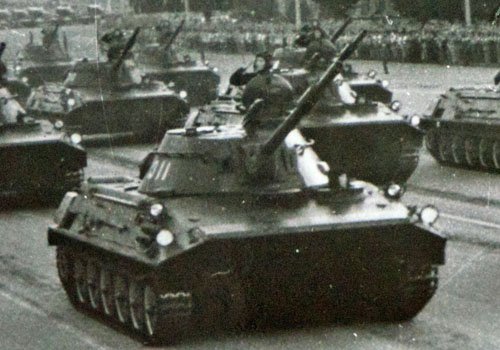
The Sinhŭng is a domestic North Korean light tank, supposedly developed in 1981, and often referred to as ‘M1985’ or ‘PT-85’ in Western sources. It features a new chassis, based on the 323 but modified and lengthened, with a turret similar to that of the PT-76, but armed with a domestic 85mm cannon, derived from the Chinese Type 63 85mm cannon. It was first revealed publicly in the parade in 1985, and was seen with a 9M14 Malyutka (Bulsae-1) ATGM fitted above the main gun, although its functionality is questionable — this is the only time the ATGM has been seen on this vehicle. Estimates suggest around 500 have been built, and they remain North Korea’s best light tank.
BR 7.0.
Armament: 85mm (domestic) + 1x Bulsae-1 ATGM launcher
Mobility: 320hp, 60km/h
Armour: Unknown, likely 10–20mm all around.
✪ Sonyeon
Sonyeon MLRS
Suggestion Post

The 323 — officially the 1973-model armoured personnel carrier 323 — is a domestic North Korean APC, produced since 1973, derived from the Chinese Type 63 / YW531A. It has been produced in huge numbers, and although in its most basic form features a turret with dual 14.5mm KPV HMGs, has been used as the basis for a number of different vehicles, including SPAA, SPGs, and MLRS. One such vehicle is designated Sonyeon (meaning ‘Boy’; named after it was ‘donated’ to the KPA by schoolchildren), and features two 2x3 122mm rocket launch tubes. The rockets used would be the same as on the BM-21 Grad and domestic BM-11.
BR 7.0.
Armament: 122mm MLRS (mod.) (12x rockets)
Mobility: 320hp, 60km/h
Armour: 12/8/8mm hull
Rank V
☯︎ Black Fox (CSE 90)
Black Fox (CSE 90)

The Black Fox (CSE 90) is a prototype wheeled fire support vehicle that led directly into the Tarantula 6x6 — a joint South Korean—Indonesian wheeled vehicle. The South Korean company Doosan developed the Black Fox APC in 2003, initially designed for the South Korean army. It lost the competition, and was subsequently advertised to export customers. In 2009, Doosan signed a contract with Indonesia to produce 43 (later reduced to 22) Black Fox APCs fitted with a CSE 90LP turret housing a 90mm Cockerill cannon — named the Tarantula. At some point before production began, a prototype / demonstrator was built, with the Cockerill CSE 90 turret. This earlier model lacks a stabiliser, and has thermals and LRF as options, instead of as standard. As such, it has a lower BR than the Tarantula 6x6.
BR 7.3.
Armament: 90mm Cockerill Mk. III M-A1
Mobility: 400hp, 100km/h
Armour: Unknown hull; Turret resists 7.62mm
☯︎ M48A1
M48A1 Patton

Beginning in the mid-1960s, South Korea began to receive large numbers of M48 Pattons — namely the M48A1 and M48A2C. Close to 1,100 were acquired. These largely replaced the M47 Pattons, although some remained in use. In the late 1970s, most, if not all, M48A1s were upgraded to both the M48A3K and M48A5K — the former featured a new FCS, and the latter was more comprehensive, including a new 105mm main cannon. The M48A5Ks remain in service to this day, but no base M48A1s do.
BR 7.7.
Armament: 90mm M41
Mobility: 810hp, 45km/h
Armour: 110/76/35mm hull; 130/76/51mm turret
Rank VI
✪ Ch’ŏnma (1986)
1976-model heavy tank Ch’ŏnma
Suggestion Post

The Ch’ŏnma — known officially as the 1976-model heavy tank Ch’ŏnma — is North Korea’s domestically-produced T-62. Some confusion exists about the exact origin of the Ch’ŏnma (license-production or reverse-engineering, or a mix of both). Regardless, the first Ch’ŏnmas rolled off the factory floor in 1976 — according to North Korea — with production ramping up in 1978 and into the 1980s. The Ch’ŏnma features the hull of the T-62 obr. 1962, and the turret of the T-62 obr. 1972, as well as a domestic modification for the mounting of a 14.5mm KPV. In 1986, one of the first of many upgraded variants would be spotted, featuring a turret bustle — possibly for additional ammunition, or for equipment storage to free up space in the turret. It also, along with base model Ch’ŏnmas, featured provisions for slat armour.
BR 8.7.
Armament: 115mm U-5TS
Mobility: 580hp, 50km/h
Armour: 100/80/45mm hull; 200/160/65mm turret
☯︎ BMP-3
BMP-3
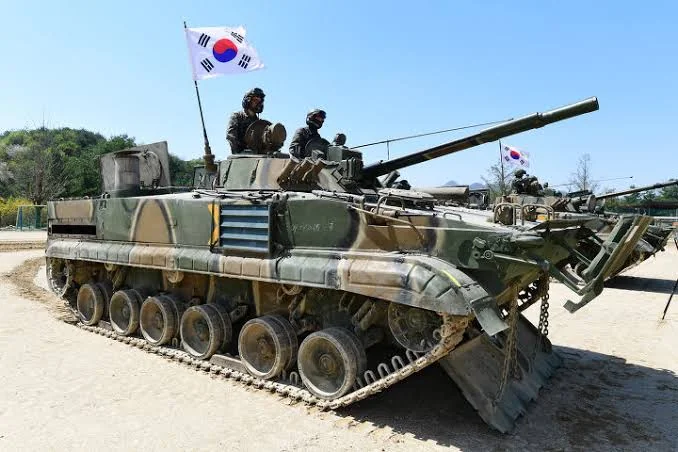
The BMP-3 is a Soviet IFV, developed in the 1980s and first produced in 1987. In 1995, South Korea and Russia signed an agreement for the delivery of a number of Russian weapon systems and vehicles in order to pay off Russian debt, including 33 BMP-3s. An additional 37 BMP-3s were received in 2002–2006 — these were modernised with Vesna-K gunner thermals.
BR 9.0.
Armament: 100mm 2A70 + 30mm 2A72
Mobility: 500hp, 70km/h
Armour: 60/43/13mm hull; 50/43/43mm turret
✪ T-72 Ural
T-72 Ural

The T-72 Ural was the first variant of the T-72, that entered production in 1973. It featured the 125mm 2A26M2 cannon, instead of the 2A46 on the Ural-1 and all later T-72 / T-90 models. Unlike later variants, its hull used the composite array of the T-64A, and the turret lacked composite entirely. North Korea acquired one T-72 Ural from Iran in the early-to-mid 1980s, who had captured it from Iraq during the Iran–Iraq war. The T-72 was studied in detail, and it heavily influenced the development of the later Ch’ŏnma variants, as well as the Sŏn’gun-915. It is likely that composite armour was reverse-engineered from it, as was the 780hp engine (likely present on the Ch’ŏnma-216), the 125mm cannon (as suggested by the fact the Sŏn’gun-915 and Ch’ŏnma-20 have external ATGMs; the D-81TM could not fire GL-ATGMS), and the overall vehicle layout.
BR 9.0.
Armament: 125mm 2A26M2
Mobility: 780hp, 60km/h
Armour: Composite array across hull, same as T-64A: 80mm RHA + 105mm glass textolite + 20mm RHA, ~440mm effective; 410/320/?mm turret
Rank VII
✪ Sŏn’gun-915 "915"
Chuch’e 98-model heavy tank Sŏn’gun-915
Suggestion Post

The Sŏn’gun-915 — officially the Chuch’e 98-model heavy tank Sŏn’gun-915 — is a domestic North Korean MBT first revealed in 2010. It is radically different to the older Ch’ŏnma-series, with much more inspiration taken from the T-72. It features a new larger cast turret equipped with a 125mm cannon, an upgraded 1200hp engine, and thick (likely composite) armour. In 2012, two new variants of the Sŏn’gun-915 were seen. The first was seen in the newly-opened KPA Exhibition of Arms and Equipment, and the second in the 2012 parade. The latter just featured new ERA, and is the production variant. The former is more interesting: it features a similar weapons package to the variant seen in 2018, but has some differences, and likely served as a testbed. It is equipped with two Bulsae-5 (9M133 Kornet) ATGM launchers above the main gun — these missiles may be mock-ups, since it is speculated that development of the Bulsae-5 was only complete following deliveries of Kornets in 2017 (these missiles were also designated Bulsae-3 at the time). It also has a dual MANPADS launchers on the right-side of the turret. The vehicle also has the same ERA package as the 2012- and 2018-parade variants. The vehicle’s number is ‘915’.
BR 10.3.
Armament: 125mm 2A26 (mod.) + 2x Bulsae-3/5 ATGM launchers + 2x MANPADS launchers
Mobility: 1200hp, 70km/h
Armour: Unknown. Hull likely has composite, similar to (or better than) the T-72 Ural + ERA across UFP. Turret claimed to be ~900mm effective (presumably against CE rounds) + ERA with ~500mm effective protection
☯︎ N-WAV
N-WAV
The N-WAV is an 8x8 IFV developed by Hyundai Rotem, first unveiled in 2023, and designed for export. It features a prototype turret on a new hull, developed from the K808 APC. The turret houses a 30mm Bushmaster autocannon and a dual ATGM launcher for the AT-1K Raybolt. It is also equipped with the hard-kill KAPS system. The vehicle has not been confirmed to have undergone trials, although Hyundai Rotem have offered it to Poland.
BR 10.3.
Armament: 30mm Bushmaster II Mk. 44 + 2x AT-1K ATGM launchers
Mobility: 700hp, 100km/h
Armour: STANAG Level 4–6 across hull
☯︎ AS21 Redback
AS21 Redback
The AS21 Redback is an IFV designed by Hanwha Defense, based on the domestic K21. It was designed specifically for the Australian Army’s Land 400 Phase 3 IFV project. It competed against the German KF41 Lynx, and won the competition, being chosen for production — deliveries are slated to begin in 2027. The vehicle features an Australian turret housing a 30mm Bushmaster autocannon, two Spike-LR ATGM launchers, and the hard-kill Iron Fist APS.
BR 10.7.
Armament: 30mm Bushmaster II Mk. 44S + 2x Spike-LR ATGM launchers
Mobility: 1000hp, 65km/h
Armour: Up to STANAG Level 6
☯︎ K1 (Late)
K1 (Late)
Suggestion Post

The K1 is South Korea’s first domestic MBT. In the 1970s, South Korea began looking for a domestic MBT on par with the Leopard 2 and M1 Abrams. Chrysler responded with their proposal, based on the XM1. Development began under the name ROKIT, and the first prototype (automative test rig) was built in 1983. Production began in 1987 — 1,511 tanks were built until production ended in 2011. The initial production batch of 477 (or 445) vehicles were fitted with the Hughes Gunner’s Primary Sight System (GPSS), which was replaced with the GPTTS on all K1s afterwards. This wouldn’t change the vehicle much, if at all, in-game, but does allow for a premium variant at the same BR.
BR 10.7.
Armament: 105mm KM68A1
Mobility: 1200hp, 65km/h
Armour: Classified composite array, using Chobham. ~400–500mm effective protection against KE frontally.
☯︎ K1A1 (P)
K1A1 (Prototype)

The K1A1 is an upgrade to the K1, very similar in scope to the American M1A1. South Korea indicated their interest in an upgrade in 1985, and official development began in 1991. The tank would feature a domestically-produced 120mm smoothbore, along with domestic ammunition. Aside from the 120mm, the K1A1 also features improved armour, utilising KSAP instead of SAP. The first prototype was revealed in 1996, and production began in 1999. The first prototype differed from the production variants, in that it retained the original commander’s sight of the K1, without thermals. In-game, it should be given worse ammunition choices than the production K1A1/K1A2 to justify a lower BR.
BR 11.0. Squadron Vehicle.
Armament: 120mm KM256
Mobility: 1200hp, 65km/h
Armour: Classified composite array, using an improved armour based on Chobham. ~600mm effective protection against KE frontally.
☯︎ T-80U
T-80U
Suggestion Post
The T-80U is a Soviet MBT, produced since 1985. It featured significant upgrades over the preceding T-80 variants, including a new turret and Kontakt-5 ERA. In 1995, South Korea and Russia signed an agreement for the delivery of a number of Russian weapon systems and vehicles in order to pay off Russian debt, including 33 T-80Us. An additional two were received in 2002–2006 — these are often reported to be T-80UKs, but this is inaccurate. In 2004, after periods of training and study, the T-80Us entered service. They are slightly modified from the originals, with South Korean radios and rubber tracks. Compared to the Soviet T-80U in-game, they would only be equipped with 3BM32 (almost identical performance to 3BM42) and don’t have a thermal sight.
BR 11.3.
Armament: 125mm 2A46M-1
Mobility: 1250hp, 70km/h
Armour: Composite array. Very strong turret and UFP at its BR.
Rank VIII
☯︎ XK2 (FTR)
XK2 (Firepower Test Rig)
Suggestion Post
The K2 Black Panther is South Korea’s most modern MBT. Initial development began in 1992 to design concepts. A number of different systems were developed from 1998–2002, including the cannon, autoloader and APS. Full-scale development began in 2003, and the first prototypes — designated XK2 — were built in 2007. One of these prototypes — the firepower test rig (FTR) — fitted the prototype K2’s turret on the K1A1’s hull. This vehicle, therefore, lacks the strong hull armour of the K2, and for in-game balance reasons, should be given a worse APFSDS round.
BR 12.3. Squadron Vehicle.
Armament: 120mm CN08
Mobility: 1500hp, 70km/h
Armour: Classified composite array, using an improved armour based on Chobham. ~600mm effective protection against KE frontally. Turret likely same as production K2, capable of resisting 120mm APFSDS.

Sources
Where vehicles have suggestion posts linked, sources are taken from there, and not listed here
‘The Armed Forces of North Korea: On the Path of Songun’. Stijn Mitzer and Joost Oliemans.
SIPRI Arms Transfer Database
https://arca.live/b/gaijin/150795375?p=5
https://bemil.chosun.com/site/data/html_dir/2020/03/16/2020031602486.html?dcinside
ds1jxm님의 블로그 : 네이버 블로그
ds1jxm님의 블로그 : 네이버 블로그
Daum 카페
Daum 카페
Daum 카페
DSEI 2023: Hanwha Unveils the K9A2 Howitzer
M109 howitzer - Wikipedia
AT-1K현궁대전차미사일 : 네이버 블로그
K21 개량 관련 : 네이버 블로그
Ch'ŏnma - Tank Encyclopedia
68 (Type 68) - Tank Encyclopedia
Ch’ŏnma-216 - Tank Encyclopedia
Songun-Ho - Tank Encyclopedia
T-80U in South Korean Service - Tank Encyclopedia
Ch’ŏnma-2 (M-2020) - Tank Encyclopedia
T-34-85 in North Korean Service - Tank Encyclopedia
https://www.army-technology.com/projects/as21-redback-infantry-fighting-vehicle/?cf-view
Cockerill® XC-8
https://www.cia.gov/readingroom/document/cia-rdp84t00171r000101030001-7
https://www.cia.gov/readingroom/document/cia-rdp85t01058r000201940001-0
https://www.cia.gov/readingroom/document/cia-rdp85t01058r000201940001-0
https://www.cia.gov/readingroom/document/cia-rdp88t00539r000400490002-2
https://www.cia.gov/readingroom/document/cia-rdp91t00712r000200380004-7
ADEX 2025 – K-NIFV, the Korean New Infantry Fighting vehicle proposal by Hanwha Aerospace - EDR Magazine
ADEX 2023 - Hyundai Rotem unveils its N-WAV 8x8 IFV prototype - EDR Magazine
https://www.jajusibo.com/20135
무장장비관 견문록(4) 6종의 전략미사일과 2종의 전술미사일:자주시보
무장장비관 견문록(3) 여섯겹으로 덮은 철통같은 공중방벽:자주시보
무장장비관 견문록(2) 고속기동전과 전면타격전의 주역들:자주시보
무장장비관 견문록(1) ‘불새’를 쏘는 ‘무적의 첨단전차’:자주시보
A Visual Guide To North Korea’s Fighting Vehicles - Oryx

